I spent RM193 at this sakura-themed artisan bread fair in KLCC, here’s why you should too
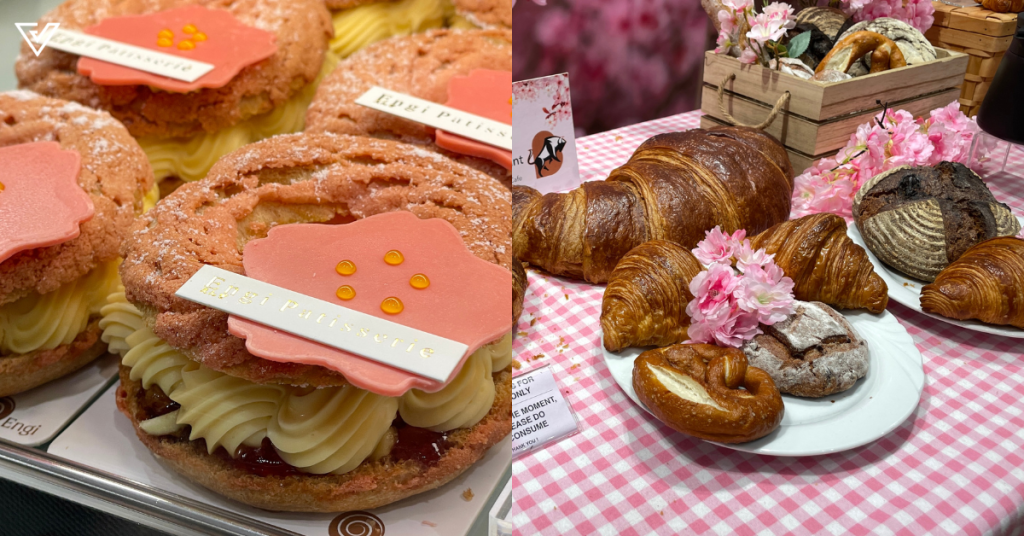
When I—certified bread fiend—saw there was a bread festival in KLCC, I knew I had to go.
I’m referring to Salon Du Pain, an artisan bread fair curated by Isetan. What’s more, it’s sakura-themed this time. What’s a girl to do but to wrangle a friend and go eat some bread?
Salon Du Pain, for those who aren’t French, literally refers to Bread Room. The theme this year is Fete du Sakura, meaning sakura party.

The event is organised by A&J HAKKO, a company that provides storage and transportation solutions for dry and frozen goods. They also import food products from Japan and assist Japanese vendors in holding various Japanese food events in Malaysia.
Its past three Salon Du Pain events seem to have been well-received by other bread lovers, enough that it’s back for the fourth time.
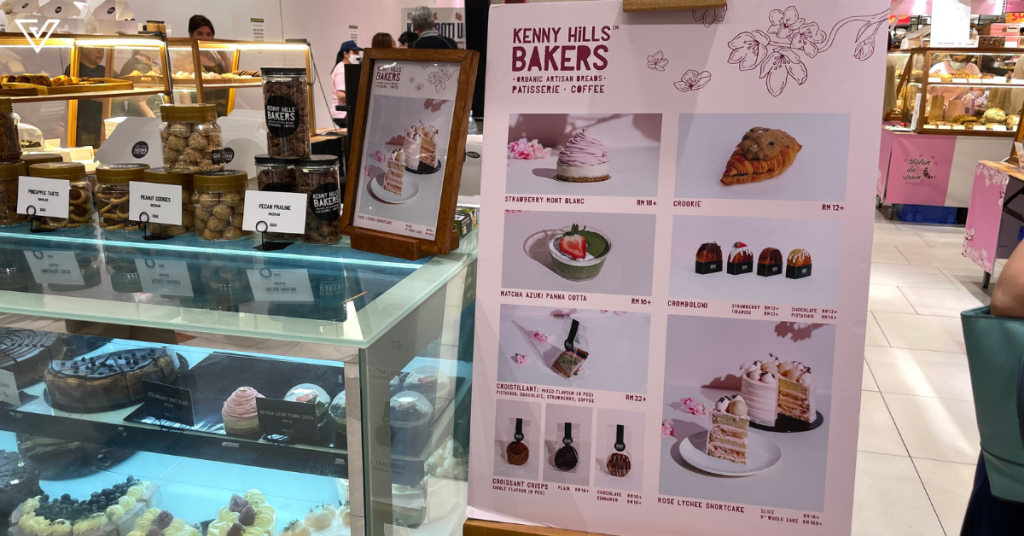
I made my way to KLCC last Sunday (April 21) and, well, I have to say that the event certainly rose to the occasion (a little yeast joke for you). Here’s why you should check it out for yourself, too.
So. Much. Bread.
Ongoing for three whole weeks, Salon Du Pain features 18 bakeries overall, the majority of which are homegrown businesses. From April 19 to 28, though, the vendors are:
- A Paris Bakehouse
- Blackbixon
- Chef K Pastry
- Doudoubake
- Engi Patisserie
- Kenny Hills Bakers
- Kona Bakehouse
- Lachér Patisserie
- Orito Bread & Patisserie
- Smith Breads & Café
- The Baking Trip
- The Dough Factory
- Universal Bakehouse
- INIC Coffee
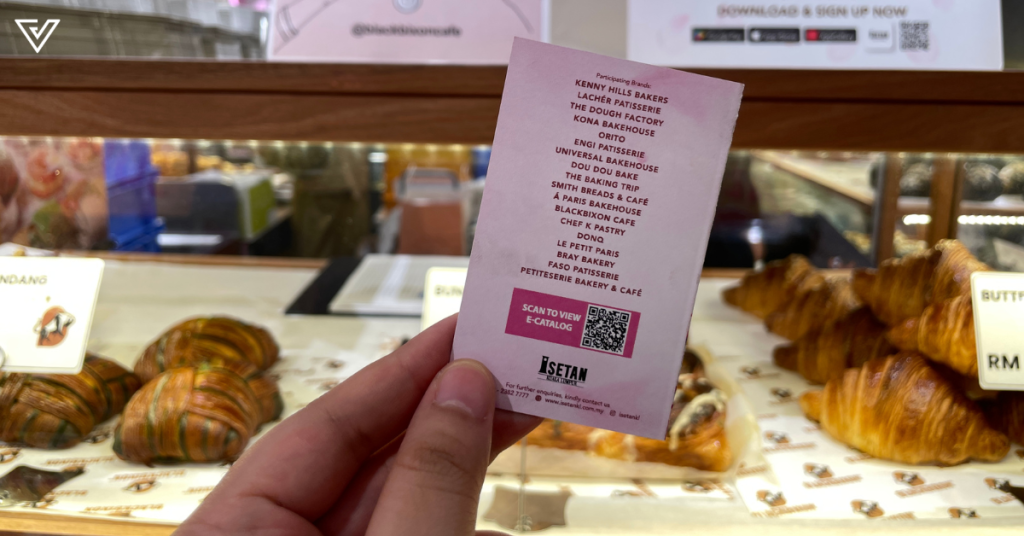
The next part, which is April 29 to May 8, the vendors—some which are recurring—are:
- Bray Bakery
- Donq
- Faso Patisserie
- Engi Patisserie
- Kenny Hills Bakers
- Kona Bakehouse
- Lachér Patisserie
- Le Petit Paris Potpourri
- Orito Bread & Patisserie
- Petiteserie by Janice Siew
- The Dough Factory
- Universal Bakehouse
- INIC Coffee
Tucked inside Isetan’s Foodmarket on the concourse level of KLCC, the fair was already bustling by the time I got there around noon last Sunday.
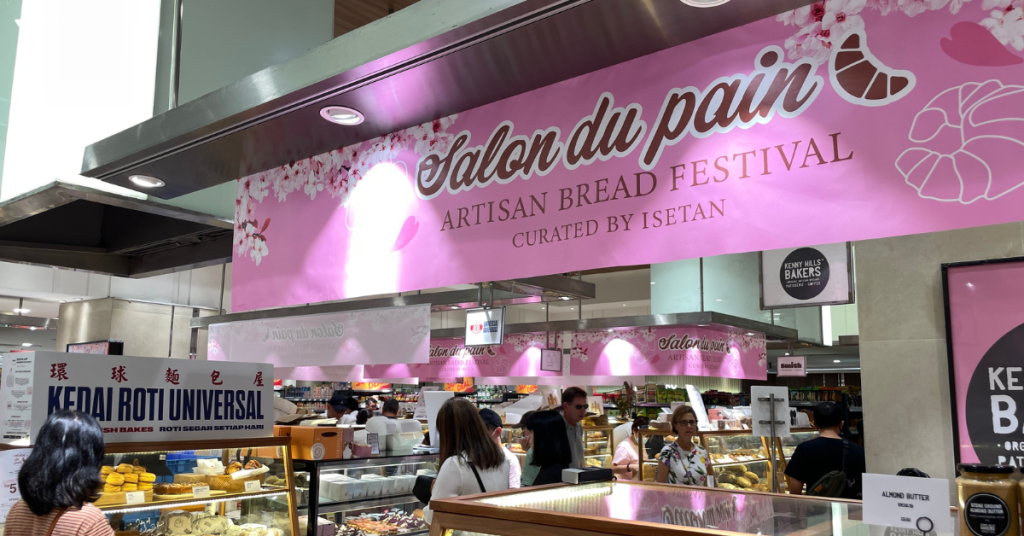
The staff members stationed at each brand were super friendly and informative. Their salesmanship must be commended as well, or perhaps I was just too easily swayed…
But how can you not be excited, when confronted by divine pastries at every corner, the scent of baked goods permeating the air?
Rather than just bringing together their usual bakes, every brand had some exclusive event-only offerings as well, which gives you an incentive to visit.
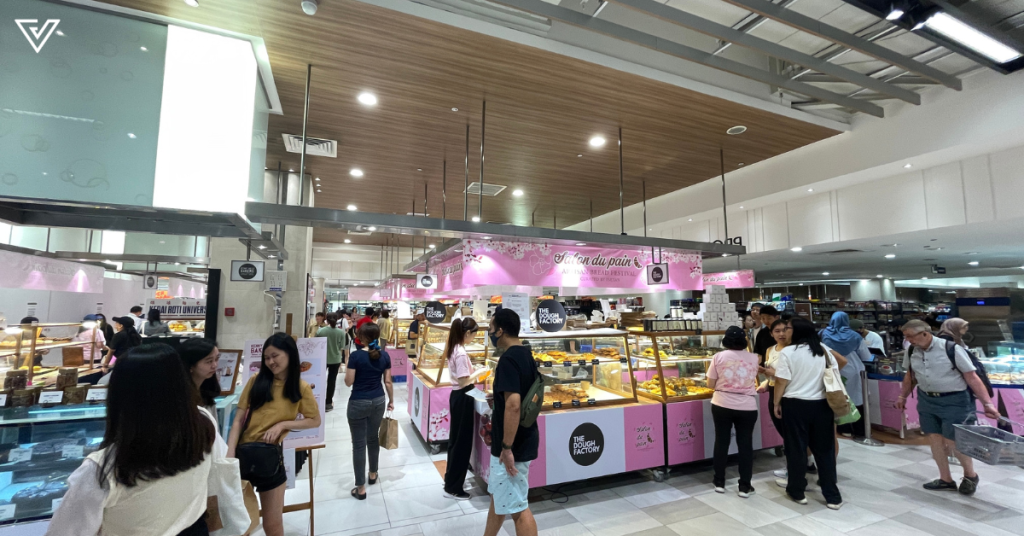
You can check out all the exclusive offerings by each brand on Isetan’s dedicated website.
Ready your wallets (and a place to eat)
I didn’t limit myself to just buying the limited offerings, as there were way too many mouthwatering breads that practically had my name on them. But boy was I tempted to just stop and buy every single one of the pink sakura treats from each store.
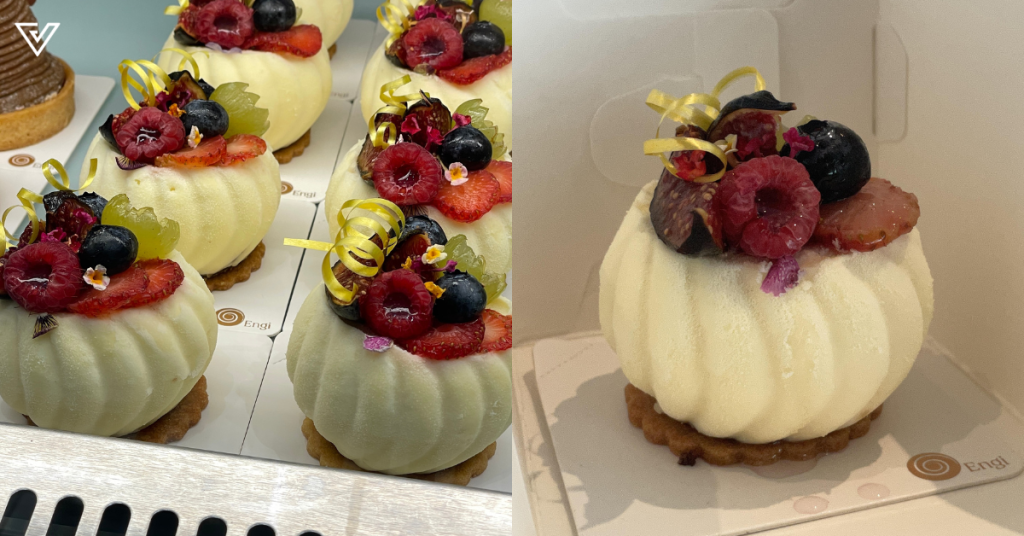
Some of my highlights were definitely Engi Patisserie’s Baba Fruits. Topped with fresh figs and berries, this petit gateau was coated in cream and had a spongey centre that I want to say was soaked in grapefruit juice, or something else that’s mildly sweet and citrusy.
Dou Dou Bake’s Tomato Heirloom Danish is a must-try for those who enjoy savoury dishes. Their Pandan Kaya Custard Danish (not an exclusive) was also incredible.
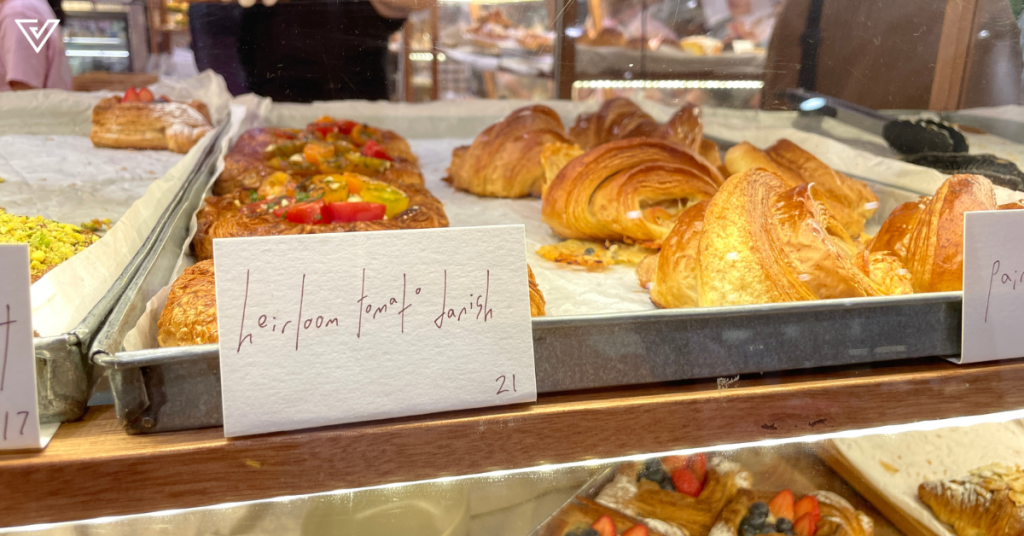
If you’re into egg tarts, the Sakura Egg Tart from The Baking Trip is a fun spin on it, except it’s more desserty with its sweet notes.
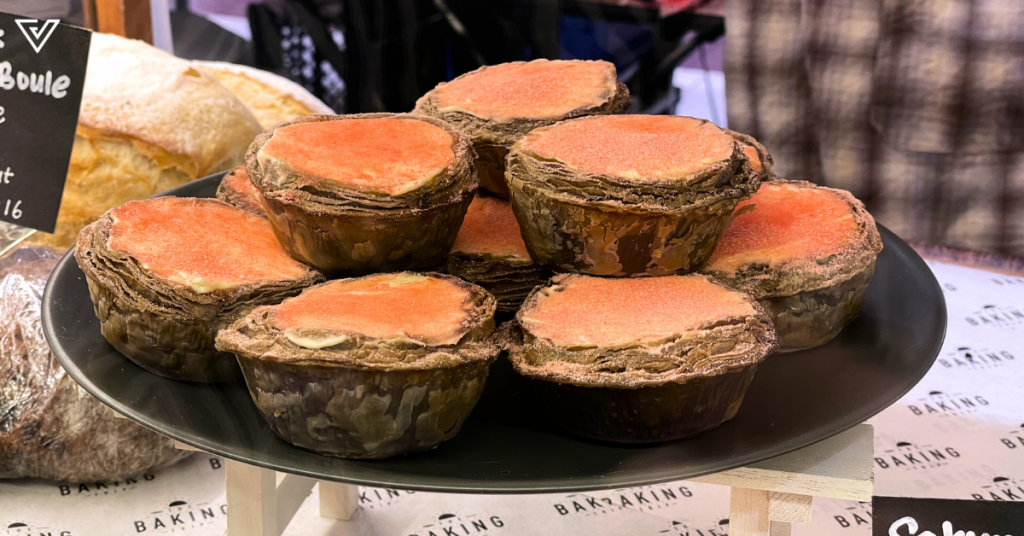
From Black Bixon, we picked up the Cherry Blossom Bowtie, which features a flakey outside and a mild cream filling with lychee notes.
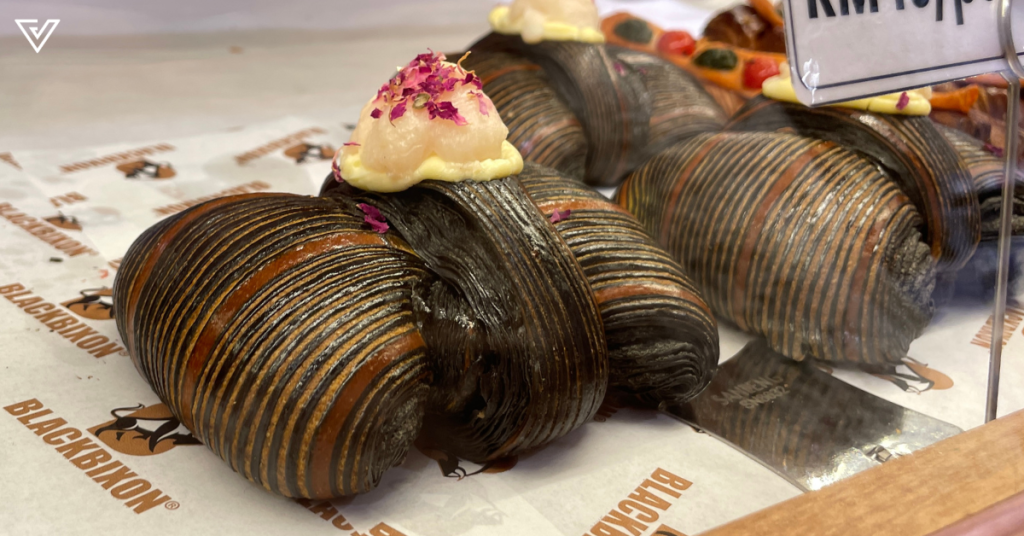
We also grabbed some focaccia from Universal Bakehouse and a truffle mushroom pastry from The Dough Factory that were both delectable.
Anyways, I can talk ad nauseum about all the incredible pastries I saw and tasted at the bread festival. If this is already intriguing to you, why not drop by anytime in the next couple of weeks to witness the glorious bakes yourself?
There’s also a lucky draw (fingers crossed that we might get the beautiful pink Smeg toaster), mystery gifts, and purchase-with-purchase offerings, such as for the cutest mini oven toasters from MOSH!. Literally, if I stood there for a second longer, I would’ve ended up buying it.
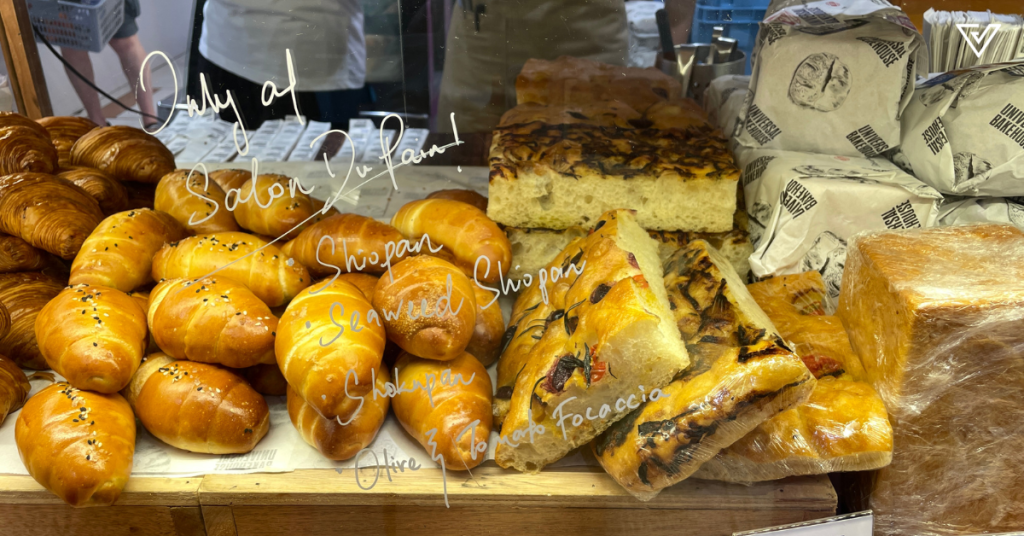
And that would be bad, because our total already came to be a pretty shocking number: RM198 split between two pax. In our defense, you don’t get pay at each vendor, but rather, they would write you an invoice that you can collectively pay for at the Isetan cashiers.
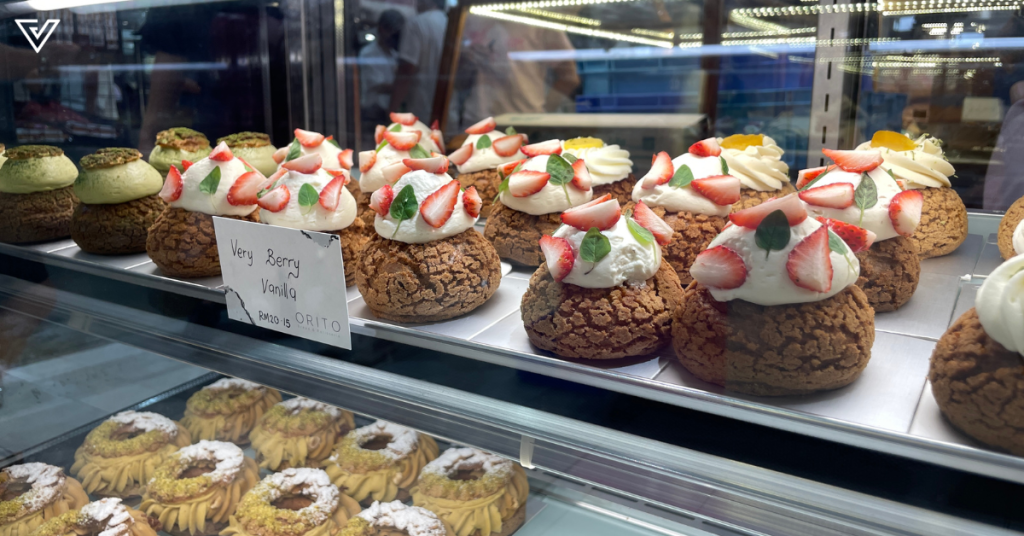
Because of that, I don’t think we realised how much we had bought, since we were just holding little slips of paper instead of the actual pastries.
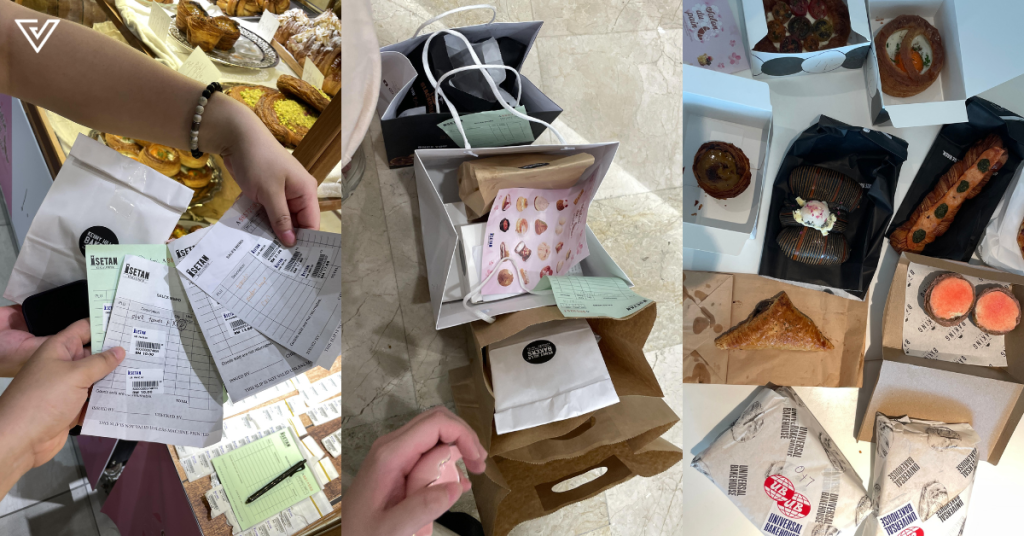
Ultimately, we still determined that it’s a worthwhile splurge for bread fiends. When else will you get to eat so many delicious breads?
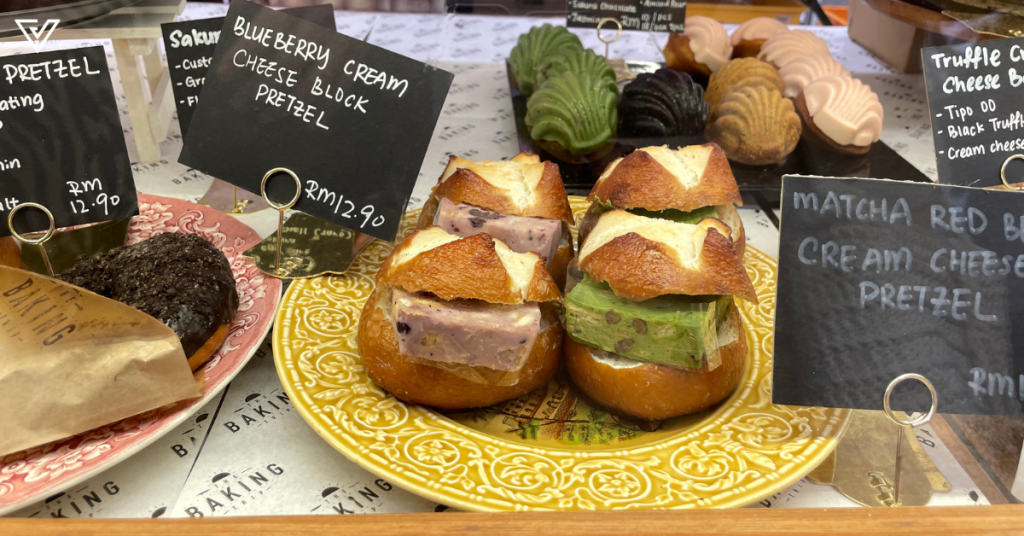
There aren’t any eating areas in Isetan, so we brought our spoils of war to the food court upstairs to enjoy alongside some drinks. Here, we were even stopped by a trio of Japanese ladies who asked us where we got our pastries. Talk about target audience.
In any case, we recommend bringing a friend (or two… or more, really) to enjoy the breads together. And hey, you can always bring your haul to KLCC Park for a lovely picnic too.
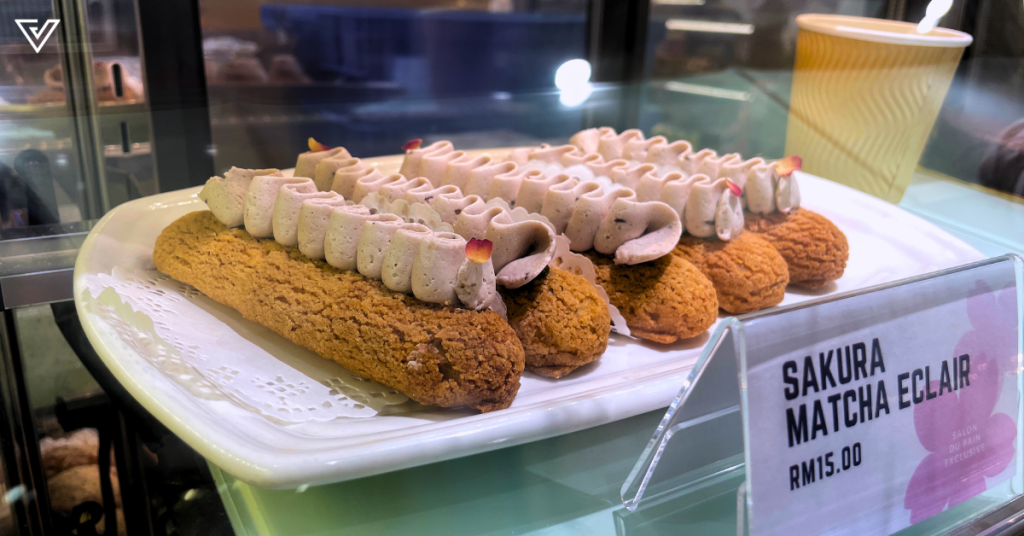
A showcase of Malaysia’s pastry potential
Earlier this year, a baker who works in Australia told me they were considering moving back to Malaysia to open up a bakery. They felt like our local scene was underdeveloped, and thus believed they may have the upper hand in offering high-quality bakes.

Maybe it’s true that our pastry scene is not as developed as Australia’s, or Japan’s, or France’s. Yet, that doesn’t mean there aren’t a lot of great bakers and patisseries in the country, as showcased by Salon Du Pain.
That might be my favourite part of the event—it was great seeing all these wonderful homegrown bakeries convene and show off their baking talents and creativity.
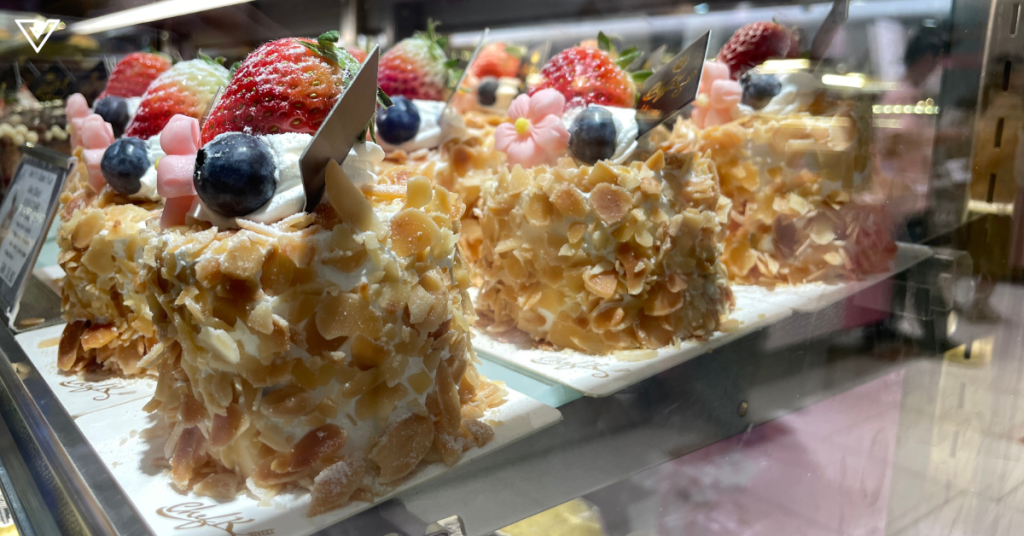
I loved that Salon Du Pain serves as a platform for them to think outside of the box and offer something out of the ordinary, too.
Even if you’re not a bread lover, I would recommend dropping by if you’re around, if only to treat your eyes to all the incredible offerings and not drop RM198 on bread and cakes.
Also Read: How financial institutions & universities are reshaping their network through AI-native solutions
How this Dewakan-trained chef puts a modern spin on traditional Chinese food at this PJ eatery
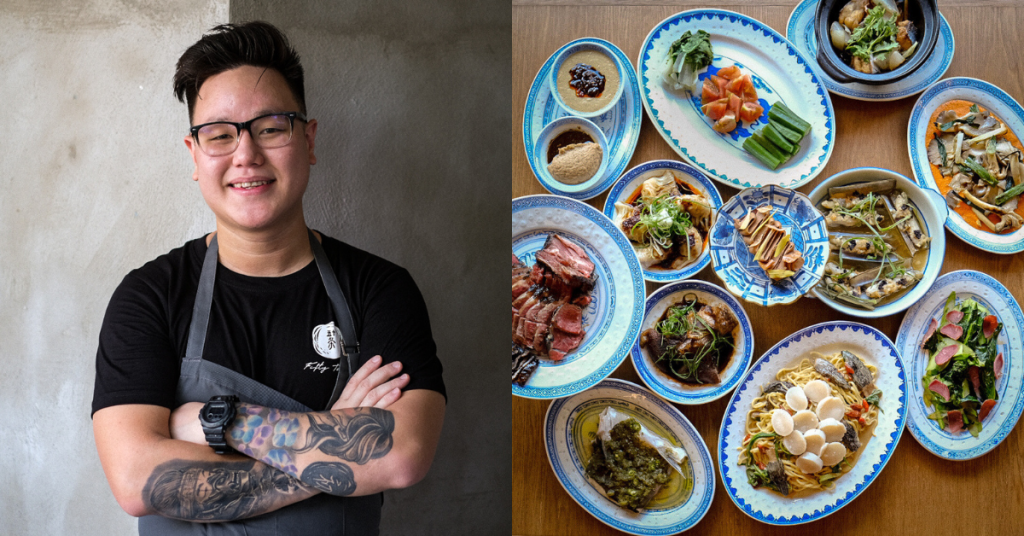
“Not Ramen”, that’s the first thing that caught my attention when stumbling upon Fifty Tales.
It’s an odd statement to make without context and I thought it was just a quirky way of branding themselves. But it turns out this isn’t a gimmick at all.
Its head chef, Aaron Khor, explained that Fifty Tales began as a noodle bar. During its early days, many people thought it was a Japanese ramen bar and left them bad reviews because of it.
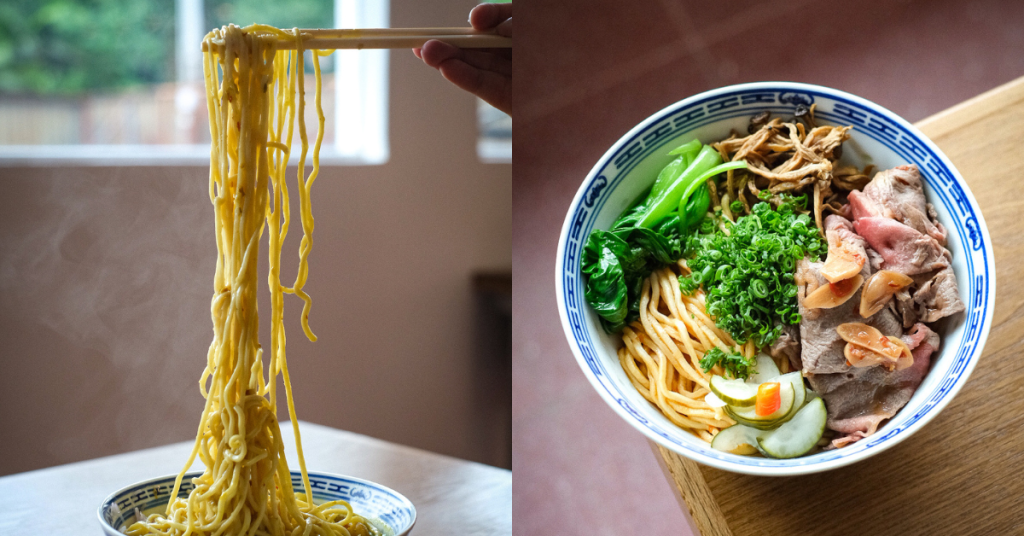
“We were confused by this, as we had no correlation or connection to Japanese branding or cuisine,” Khor recalled. However, the incident made them realise how undervalued Malaysian Chinese cuisine was compared to imported ones.
“It started out with a simple question—why are we okay paying RM40 to RM50 for a bowl of Japanese ramen, but not RM20 to RM30 for a bowl of Malaysian Chinese soup noodles?”
So Khor and his two co-founders, Aaron Phua and Bimmy Soh, decided to change that and show just how special local food can be.
Revamping traditional classics tastefully
I know what you’re thinking, plenty of other restaurants in Malaysia claim to do the same thing. If everyone is doing it then how “unique” is it really?
Fifty Tales’ take on this is by offering a modern twist to traditional Chinese dishes you grew up eating. This isn’t to be confused with fusion cuisine where you mix two cultures in one plate.
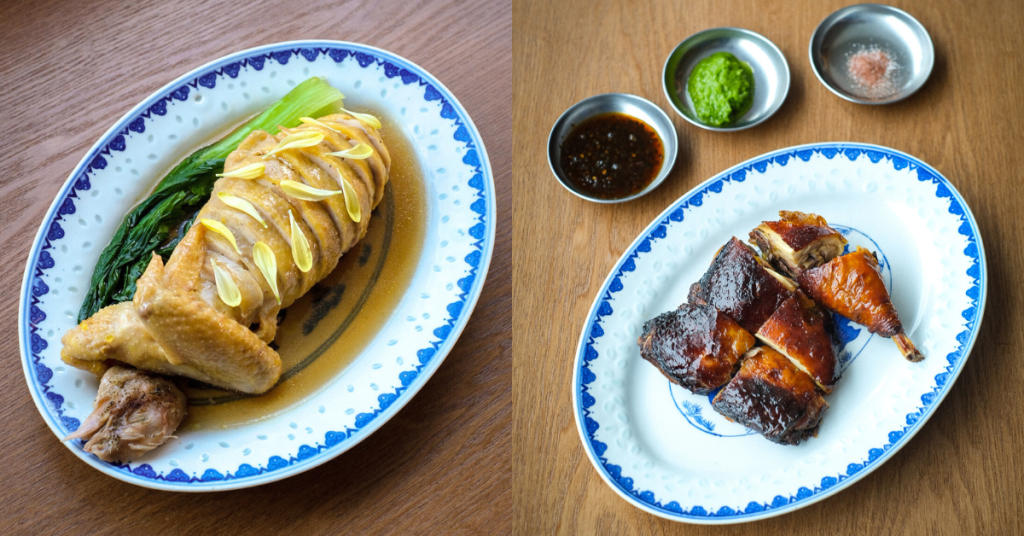
What Khor and his team do is look back at legacy cuisine that has lasted through the test of time and give it a modern spin. “We try our best to make it more refined and elevated, using better ingredients and techniques that are relevant today,” he explained.
For example, the restaurant offers Roasted Corn-Fed Chicken Leg as part of its dinner menu called Cincai Dinner. Instead of just scallion oil, Khor uses kulim oil which is known as “jungle garlic” due to its garlic aroma.
Fun fact: Kulim oil is also dubbed as the “truffle of SE Asia”. One local brand that creates and sells this is Oylhaus.
Besides that, the restaurant also looks at traditional cuisine from different dialects, such as Cantonese, Teochew, and Hokkien.
The idea for this came from getting to know their team better and learning the different food they grew up eating. “We realised there were more differences between each of us than things being common [and] we wanted to highlight that,” he shared.
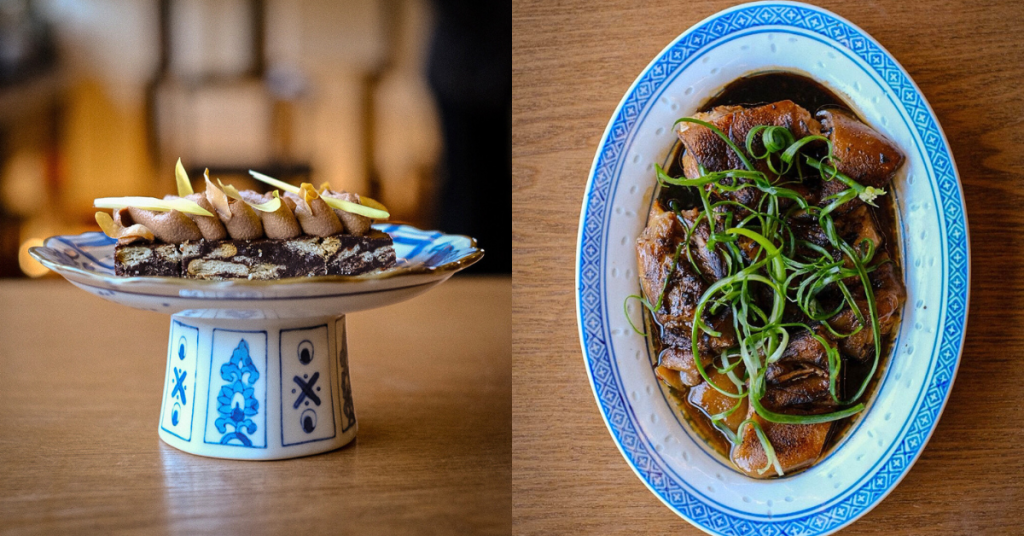
Hence, you can find dishes like Braised Pig Ears (a Cantonese dish) and Steam Sabah Razor Clams (a Hokkien dish) at its PJ outlet.
But if that’s not up your lane then you’ll still be able to find the restaurant’s initial noodle offerings during lunchtime.
The team isn’t a fan of complacency
All that said, being part of a young team, Khor shared that the offerings at Fifty Tales aren’t stagnant. The restaurant makes it a point to innovate their menu about every quarter of the year.
They would also come up with special menus for festive seasons like Chinese New Year and the Mooncake festival. But don’t worry if something you like is taken out, as they usually bring back dishes that customers know them for.
Many of these items are developed by Khor himself, though his partnering co-founders and team give their input as well. Testing and trials are done internally to ensure a dish gets the green light beforehand.
Having trained in the now two-starred Michelin restaurant, Dewakan for two years, Khor is well-equipped to handle this responsibility.
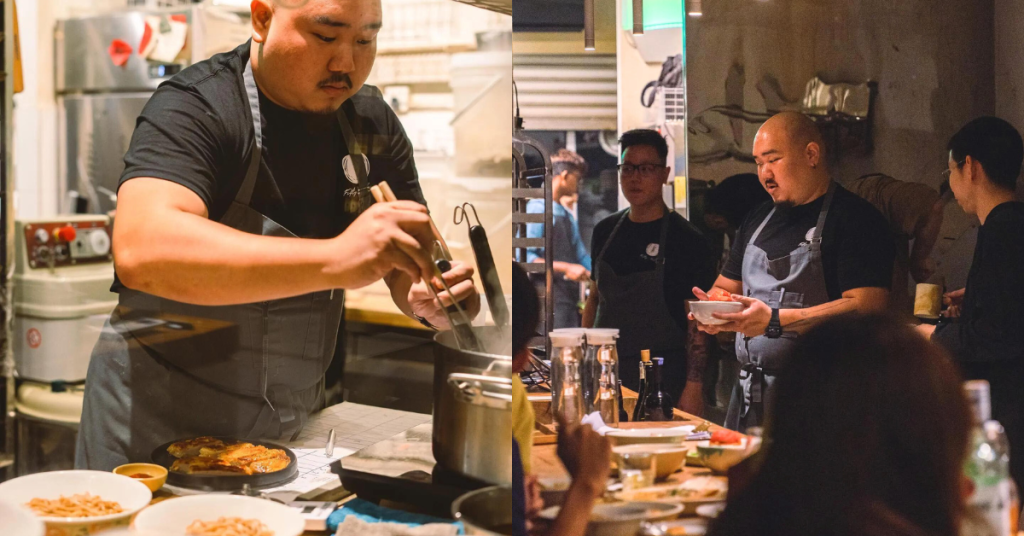
He’s supported by Phua and Soh who have equally established credentials. For context, Phua also runs another cafe called Thirty Seconds, whereas Soh was culinarily trained in Australia for seven years.
Fifty Tales was the brainchild of Phua and Soh who were classmates in Berjaya Campus. Khor joined them a year after its inception as head chef and later became a business partner. Together, the trio grew the restaurant from a noodle bar to the family-oriented establishment it is today.
Aside from the food, another way they’ve grown the business is through collaborations with other local and international chefs, including ClubSoda in Bali and Sugarhall in Singapore.
This ongoing initiative is their effort to create unique experiences. At the same time, it’s also to bridge connections with different chefs and restaurants around the world and create a community.
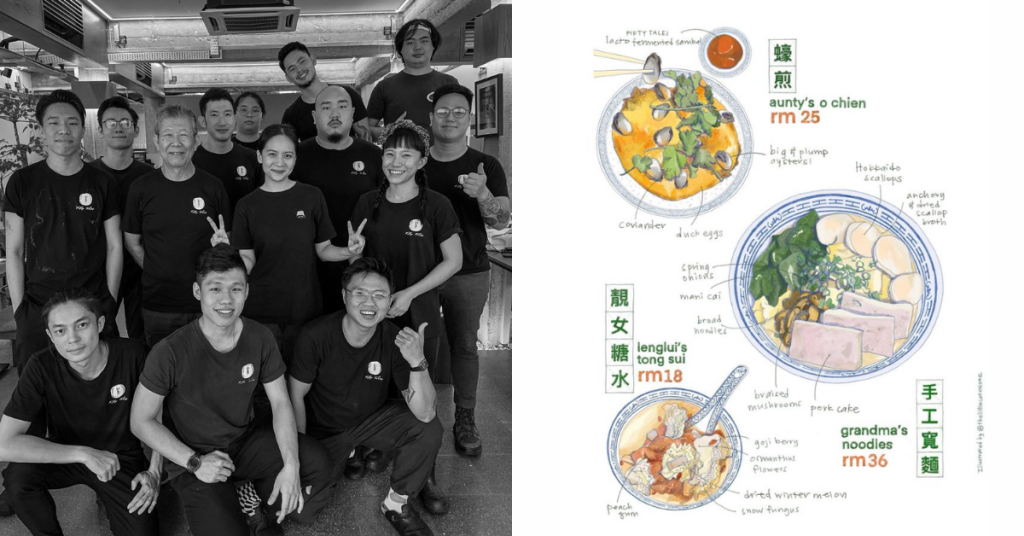
Growing with customers and present times
The modern Chinese restaurant mainly aims to serve those in their mid-30s and above. This is because their dinner menu is engineered in a way that it’s suitable for sharing amongst big families and groups.
Once the communal dishes are decided upon, customers can choose to pair them with plain rice or their signature “Ren Li Mian” (handmade noodles).
However, this will change as time goes on. The team finds it important to adapt to current times and understand that their target market will never be fixed. Mid-30s will later become mid-40s, so on and so forth.
“We grow with our customers, remembering our regulars and making sure they feel heard because they’ve supported us from day one,” Khor said.
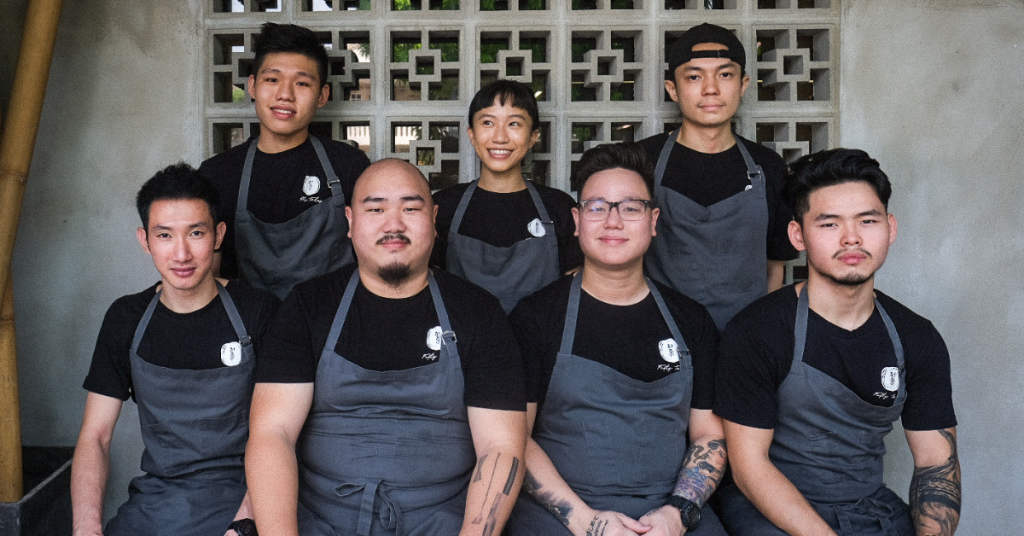
This is also another reason why they’ve stuck with Cincai Dinner as well. It initially started as a way to adapt to the challenges of surviving COVID-19, but many diners requested they keep it so it’s now a mainstay.
Ultimately, Khor and his team want to be both a reminder of their customers’ childhoods and futures by providing nostalgic yet innovative food.
In some ways, it echoes Khor’s culinary background at Dewakan, where the restaurant’s founder (Darren Teoh) once shared that “tradition is fluid” and needs to evolve and change with time.
Also Read: Employees need a Copilot to boost productivity & ease brain drain. This webinar shows how.
Featured Image Credit: Aaron Khor, the Dewakan-trained chef that helms Fifty Tales’ kitchen / Fifty Tales
This S’porean biz enables parents to keep their kids’ artworks forever without the clutter

If there’s one thing that most Singaporeans struggle with, it’s space. Being on a small, albeit economically prolific island means that many of us don’t have the luxury of extra space.
So you can imagine the headaches this brings.
On one hand, you’re a hoarder who loves to keep the artworks that loved ones made for you. On the other hand, you just don’t have the storage space for it. Keeping the artworks takes up too much space but throwing it means losing precious memories.
This was an issue that Natasha and her two co-founders, Li Ting and Sharon Chan, were all too familiar with.

As mothers, they faced the dilemma of preserving their children’s artworks without drowning in clutter. “I vividly recall relocating from the US years ago with just two trash bags filled with my daughter’s artwork, only to regret discarding them later,” Natasha shared.
But we’re living in the modern age where tech has made life easier, which is exactly what they turned to for a solution. Thus, Artispique was born as a platform to help others preserve and digitise their memories into a personalised art book.
A timeless curated memory vault
Also called the “Memory Vault”, Artispique’s personalised art book (SG$108) is its debut offering that turns keepsakes into both digital and hard copy memorabilia.
The possibilities are quite endless as customers aren’t limited to only 2D items. According to its website, you can also convert 3D crafts, trophies, and awards as well. Soft copy images are also welcomed so long as they’re high resolution files.
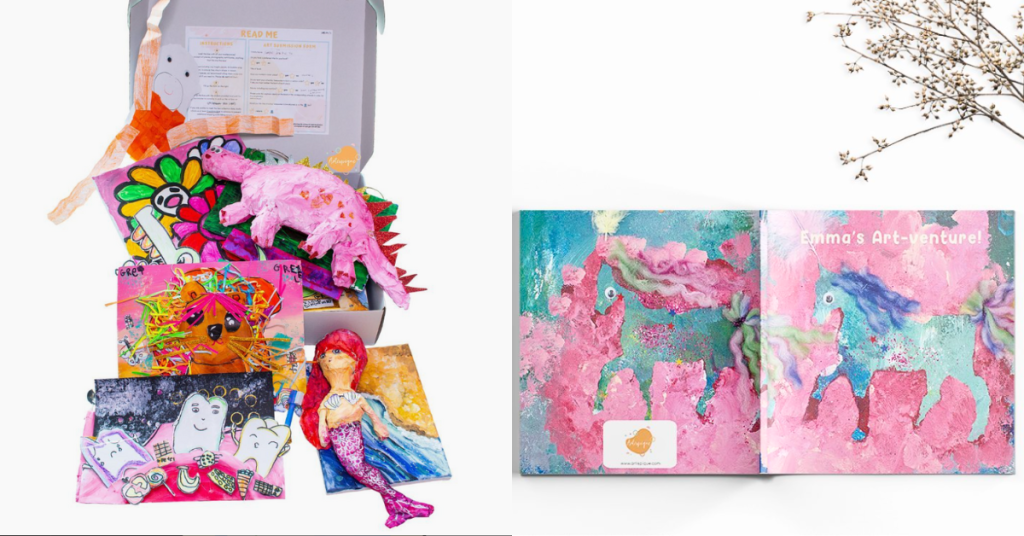
To make it simpler for customers, Natasha and her co-founders also designed the process to be seamless.
Once an order is placed, the brand will send over a pre-paid art collection bag. You can pack up to 20 artworks that you’ve curated to be immortalised. Natasha recommends wrapping the more fragile items with paper towels or used clothes.
Each art collection bag comes with a starter kit, where you’ll have to scan a QR code and fill up the art submission form. You’re able to choose add-ons here such as a premium book cover (SG$20) that includes a superimposed photo and a book title.
Pick-up is then arranged and all you have to do is stick the airway bill and pass it to Artispique’s courier partner.

From there, Artispique’s team works their magic to carefully curate and digitise each masterpiece before compiling them into your own art book. This includes detailed restoration works, so you don’t have to worry if the artwork is on crumpled paper.
A draft is shared with you for approval before they proceed with the printing. If you’re interested in feeling the books in person before placing an order, you can visit their affiliated partners in art schools.
It’s not just for parents with young kids
Besides art books, the online brand has expanded its product range to include Pique Fine Art Print (starts from SG$88), Personalised Money Envelopes (SG$38.80), and Customised Doodley Mug (SG$48).
This diversification was in response to market demands and served as another way for customers to cherish their memories. After all, not everyone is a fan of books. I myself enjoy donning artworks as a form of self expression and appreciation.

That said, personalised art books remain the brand’s main revenue stream. “They’re the heart of our brand and resonate deeply with our customers,” Natasha stated.
One of the brand’s most memorable clients so far is one such case. Sharing with us, Natasha explained that a customer once approached Artispique with a heartfelt request to curate a memoir for her nephew.
“Tragically, her sister (the boy’s mother) had passed away during the pandemic. Wanting to preserve her late sister’s memory in a tangible and meaningful way, our client sought to compile all of her sister’s Facebook posts into a book for her nephew.”
The memoir wasn’t just about preserving digital content, but the posts captured the essence of a mother’s journey. Specifically from her anticipation of the pregnancy to the daily moments of raising her son.
It was meant to be a gift for his 12th birthday, as a means of helping him feel her presence and cherish her words.
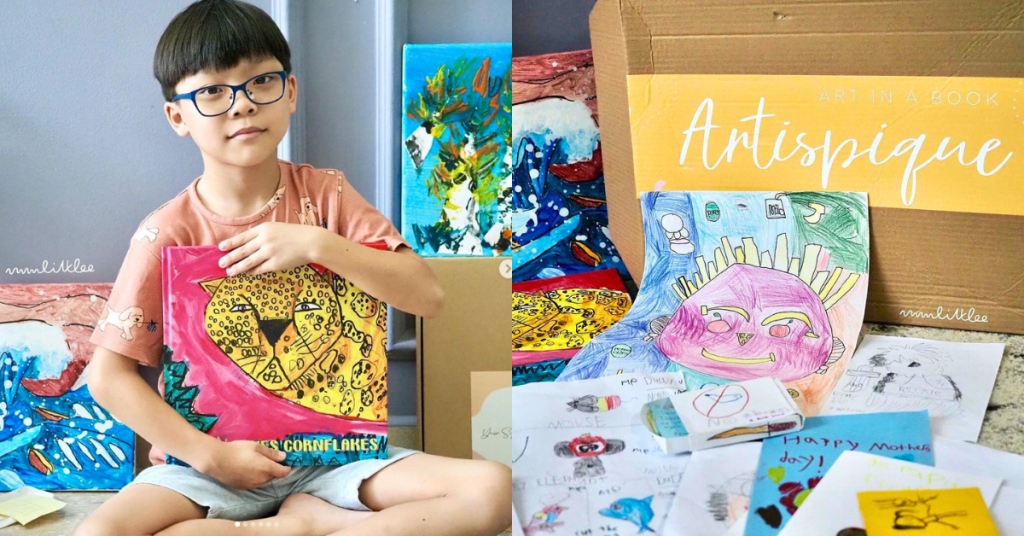
It’s projects like these that remind the Artispique team of the profound impact services like theirs have on others during difficult times. “They reaffirm the importance of what we do and drive us to continue providing meaningful solutions for our clients,” Natasha said.
It’s okay to serve a niche market
So far, Artispique has been aiding Singaporeans in digitising their artworks for about four years now. The team has grown beyond just the co-founders with a team of remote editors supporting their operations.
Natasha is the only one helming the business at the moment as Li Ting and Sharon took a hiatus since early 2023. Though, they remain as advisors in key decision-making areas.
It wasn’t easy at first because the three co-founders each had their own roles. Li Ting handled financial matters, Sharon led event planning, while Natasha was in charge of all things creative.

But she took it as an opportunity for growth and cited her team’s support as being crucial in those early days.
As for the brand itself, some might find Artispique’s offerings to be too niche but there’s certainly a market for it. Not to mention the meaningful impact it has towards the lives of customers, which they highlight on the website.
“As parents, one of the greatest encouragement we can give to our child is to be [in]vested in their learning process. This act of support and encouragement can go a long way in empowering our child to become confident learners who are more likely to persevere even in the face of mistakes or failures,” it states.
“Or, you could also give yourself the same encouragement by choosing to document your unique journey in art making, and reminding yourself that you are always in a process of learning.”

With that in mind, Natasha and her team hope to explore opportunities for international expansion. While it’ll aid in growing their profitability, the bigger goal is to connect with families and art enthusiasts globally.
Also Read: Employees need a Copilot to boost productivity & ease brain drain. This webinar shows how.
Featured Image Credit: Artispique / Da Little Art School
Airbot’s new self-cleaning robot vacuum boasts 3 promising features, we test each one out
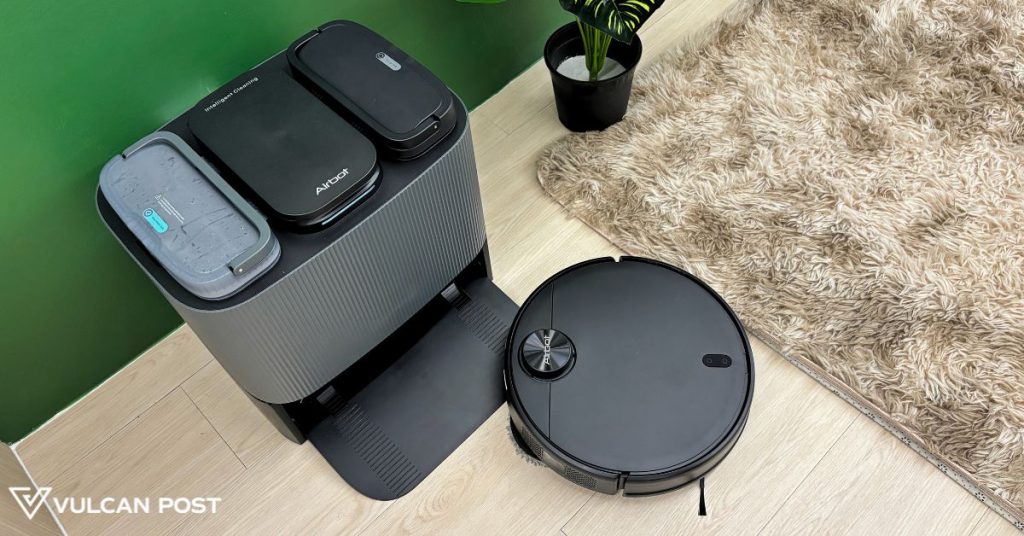
[This is a sponsored article with Airbot.]
I’ve been a big fan of robot vacuum cleaners for their ability to maintain the upkeep of my home by cleaning up dust, dander, and fur without me having to lift a finger.
However, my glee is often dampened by the tedious task of maintaining the unit itself, as my past experience can attest.
As someone with dust allergies, it may be worth investing in a self-sufficient robot with auto bin-emptying capabilities.
So when Airbot came to us to review its newly launched self-cleaning Robotic Vacuum L108S Pro Ultra, I decided to put it to the test based on its promising features.
For context, Airbot is a Singapore-founded brand specialising in air dynamic engineering technology to create high-quality and affordable home appliances for consumers.
Airbot’s product line comprises vacuum cleaners, air fryers, and air purifiers, to name a few, and they’re distributed around China, Japan, Hong Kong, Singapore, Malaysia, and Thailand.
Setting up my little helper
The robot vacuum cleaner is relatively easy to set up. It comes with an extensive set of attachments and accessories to plug and play once you connect it to the Airbot app.
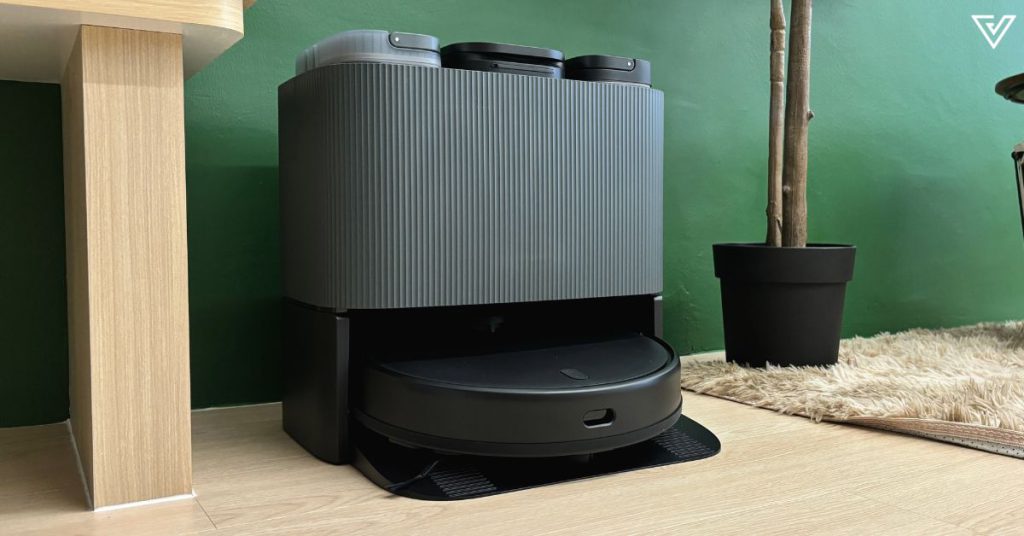
The box included the vacuum’s charging dock which contains the clean and dirty water tanks and dust collection bag, the robot vacuum with its attached brushes, power cable, and user manuals.
It also contained replacement units for its E11 HEPA filter, dust collection bag, hex side brush, and a tiny cleaning brush.
Testing its promising features
Feature #1: It can smartly map rooms and suggest No-Go Zones
Boasting advanced LiDAR mapping, the Airbot L108S Pro Ultra claims that it can automatically recognise rooms, detect easy-to-get-stuck areas, and propose No-Go-Zones. This will then display invisible walls to block certain areas, which can be further tweaked in the app.
Airbot also states that the robotic vacuum detects and avoids obstacles with ease, with a cliff sensor that prevents it from falling down stairs, for example.
Reality:
With the battery fully charged, which gives the robot up to three hours and 40 minutes of battery life, I let the robot explore my space.
I was impressed by how the robot’s advanced LiDAR mapping could predict the area’s layout even before it completed its first cleanup round.
In terms of its obstacle avoidance, I suppose it somewhat lived up to its claims?
During its first few cleanups, the robot’s collision bumper on the front would bump into partition walls and furniture, and rev up its motor while trying to mount onto carpets. This is rather normal for robot vacuum cleaners in my experience, especially in their mapping stage.
After three complete cleanups, the map was saved, and the Airbot L108S Pro Ultra navigated with fewer bumps.
That said, if a chair sits slightly out of its previously mapped spot, the robot would still bump around its legs to clean under the area—kudos for a thorough cleaning job.
Interestingly, throughout my week of testing, I did not notice the robot suggesting any No-Go Zones in the app. Perhaps it didn’t detect any easy-to-get-stuck places in its surroundings.
However, I did manually set up No-Go Zones for areas like the washroom and carpeted areas, which was simple enough to do, and resulted in smoother subsequent scheduled cleanings.
Feature #2: It can deep clean floors
The Airbot L108S Pro Ultra features an 8,000 Pa suction power when vacuuming, which is stronger than typical robotic vacuum cleaners in the market (average of 2,500 to 3,000 Pa). Essentially, the higher the Pa value, the greater the force of lifting debris off the floor.
Mopping-wise, the robot is marketed to have a 400ml high-capacity ionised Ag+ water tank and hot water activation feature. Simply put, this function is meant to heat up water and get the Ag+ ions activated to kill germs and bacteria on the floor.
Reality:
When put through a regular cleanup, the robot performs as expected picking up dust, dirt, and hair around the space.
Its suction power would also auto-adjust between Eco and Standard modes based on the dust levels it detects, and switches to Strong or Max mode if it’s cleaning a short or long-haired carpet.
Other than dust and hair, it also sucked up larger particles like cookie crumbs relatively well. The robot would use its hex-side brush attachment to push crusty debris towards the vacuum’s main brush to be suctioned into the dust compartment.
With 200rpm dual spinning mops, it cleaned up my coffee spills with no issue either. The robot’s mops are capable of pressing down with up to 500g pressure, mimicking a human’s manual deep cleaning.
What I liked about the Airbot L108S Pro Ultra is that the mop function contains some notable features at its base station.
For one, I could adjust the mop’s wash interval times between eight to twelve square metres to ensure that the mop stays fresh and clean throughout its cycles. This prevents the mop pads from spreading around sticky spills throughout the entire space.
This leads me to my favourite aspect of the Airbot L108S Pro Ultra.
Feature #3: It’s self-cleaning and self-emptying
The robot’s charging dock can self-empty the vacuum, meaning it can considerably reduce one’s contact with dust, which is particularly beneficial for those plagued with allergies.
Inside, you’ll get a 2.8L clean water tank, a 2.4L sewage tank (as Airbot calls it), and a 2.7L dust bag that can clean out the robot’s dust cup. Airbot claims that you won’t have to change the dustbag for up to seven weeks’ worth of vacuuming.
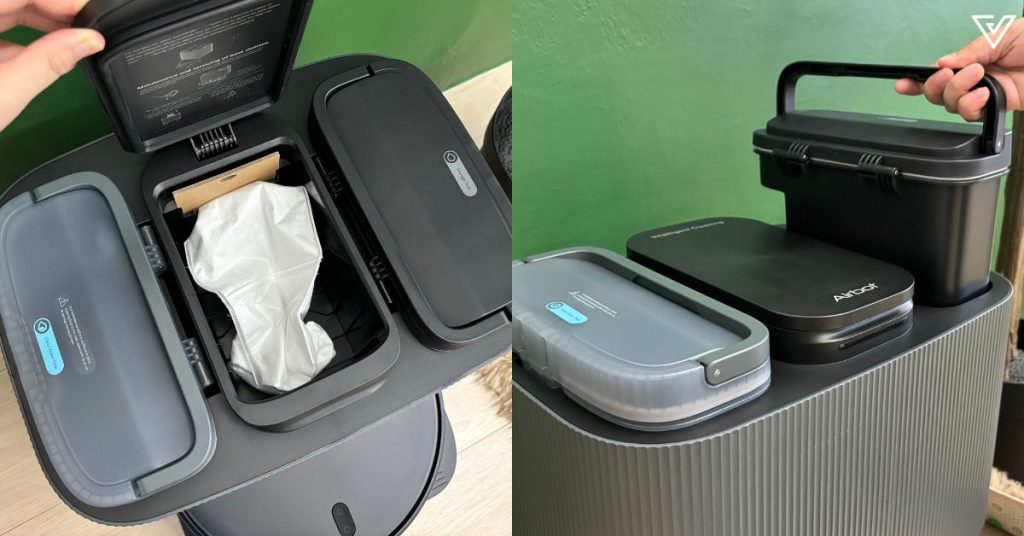
Additionally, the charging base has a warm air drying feature to dry the mop pads and prevent mould and bacterial growth.
Reality:
The Airbot L108S Pro Ultra lived up to its claims.
The clean water tank could supply enough water to the robot for a week of scheduled daily cleaning, and the sewage tank thoroughly cleaned the robot’s mop pads as advertised.
Even the coffee spill the robot mopped up didn’t leave any stains on its microfibre mop pads. The warm air drying feature could dry the mop pads in three hours, which meant that I didn’t have to separately remove and air dry them after each cleaning session.
And alas, my most appreciated feature of the Airbot L108S Pro Ultra is its effective and efficient dust-collection abilities. On the app, I scheduled to have the base empty the robot’s dust tank after every third vacuum cycle.
This meant that I wouldn’t have to confront the large clumps of dust that would gather in a normal vacuum’s dust tank, which may or may not disperse into the air, and trigger my allergies.
-//-
After all that cleanup, emptying the tanks from the Airbot L108S Pro Ultra’s base was a breeze.
The dust bag had already consolidated all the gunk from the vacuum, and once it filled up, it just needed to be replaced with a new one.
Meanwhile, the sewage water could be easily dumped into the drain and rinsed briefly before the next cleaning cycle.
Ultimately, there’s no way of completely avoiding the loose hairs and dust that get trapped onto the detachable brushes of the robot. The tiny cleaning brush provided in the box came in handy here.
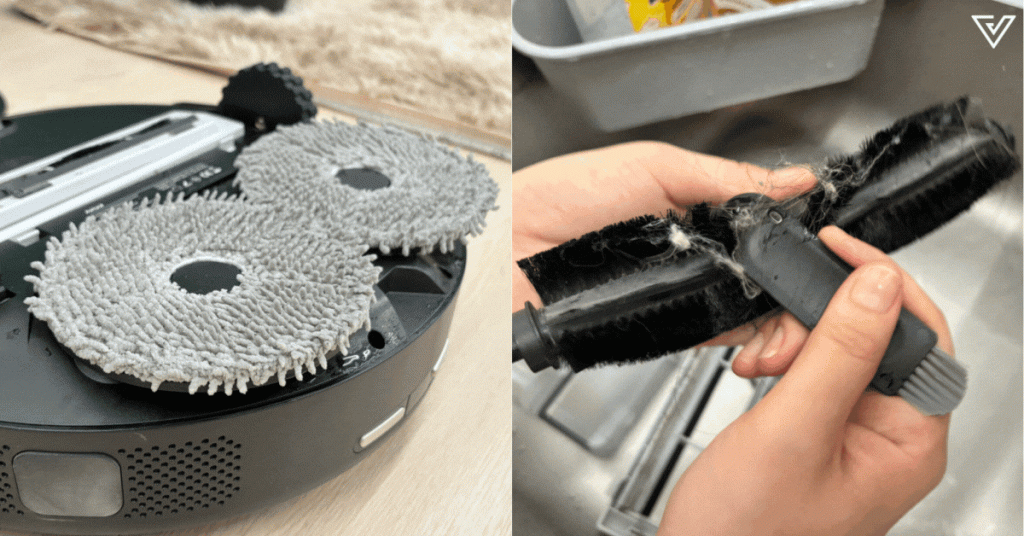
The Airbot app was intuitive to use as well, giving me remote access to the robot’s functions. I could set up the robot’s scheduled cleaning times, edit its virtual map, and monitor where it’s cleaning in my space.
I could also direct the robot’s path with the app’s remote control, adjust the base’s self-cleaning frequency, view its charging status, and be notified when it’s time to change its consumables (HEPA filter, brushes, dust bag, etc.).
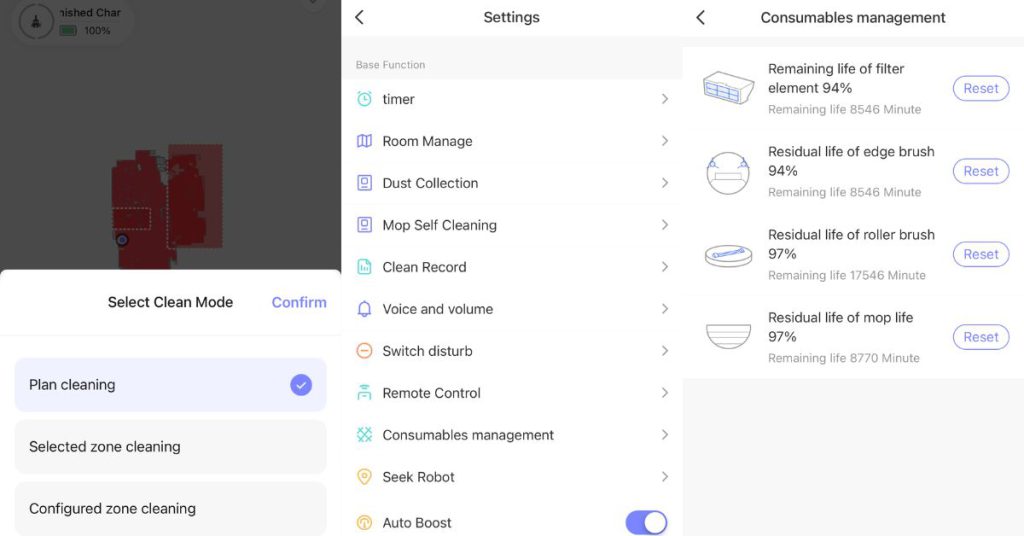
All in all, the Airbot L108S Pro Ultra would be a great helper to have in any household or office to maintain overall cleanliness.
Of course, it’s important to ensure that all cables and small objects are removed from the floor so the robot won’t get stuck in the process like ours did a couple of times.
Priced at RM2,399 (from its original RM5,199), the Airbot L108S Pro Ultra is available for sale on Airbot Malaysia’s official website and its authorised Lazada and Shopee stores.
The device’s one-year warranty (serviceable at Airbot’s service centre in Klang) will be automatically activated when the product is shipped out from its local hub.
Also Read: Here’s the startup idea that won these Sixth Form students RM50K from 1337 Ventures
Featured Image Credit: Vulcan Post
With names like “After Sex” & “Mixed Feelings”, this M’sian biz positions its perfumes as moods

There are probably tens of thousands of different perfumes available today, each one having its own unique scent.
But in a world where these scents often tell stories untold, two brothers embarked on a journey to rewrite the narrative of perfume by bottling up moods in a bottle.
The journey of moods
Founded by the dynamic duo consisting of Alan Koo, 27, whose background spans architecture and fashion design, and Damon Koo, 25, with a foundation in computer science, Klone is a brand that seeks to change the essence of perfume shopping.
Alan and Damon’s foray into the fragrance industry was a leap of faith, driven not by experience but by a desire to create something that resonated with their personal ethos.
“We had no experience in the fragrance industry at all. We are just trying to create a brand that is cool and fun,” Alan candidly admitted.
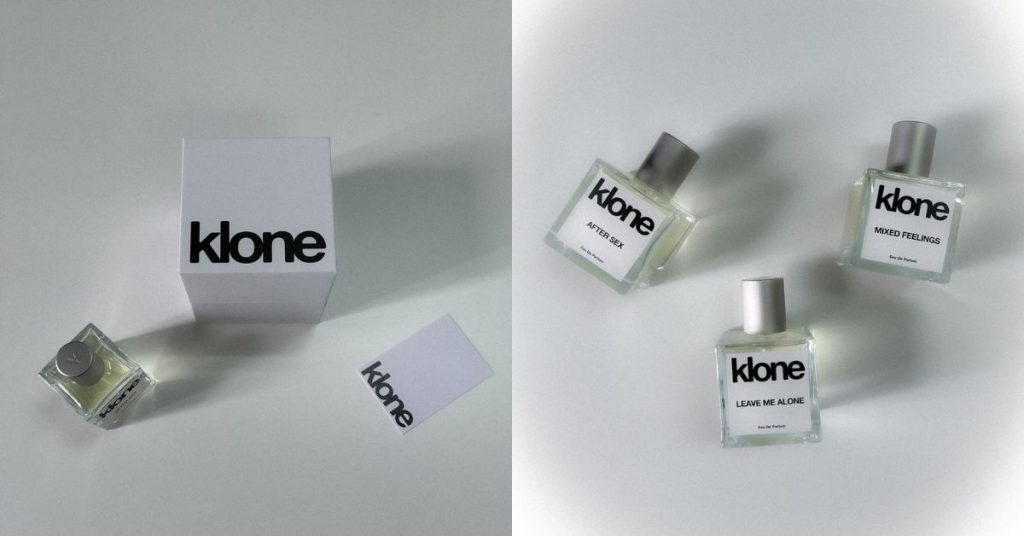
This lack of conventional industry wisdom led them to approach perfume-making with fresh eyes, unencumbered by industry norms.
At the helm of Klone’s operations, Alan spearheads the creative direction and marketing endeavours, infusing the brand with his keen sense of design and aesthetics.
Meanwhile, Damon takes charge of the web store, logistics, and the intricate process of perfume manufacturing, leveraging his expertise in computer science to streamline operations.
“We run this business full-time but it is more of a side hustle at the moment,” Alan said.
What they sell
The birth of Klone’s concept lies in its departure from the traditional paradigm of scent-based marketing.
“We just started by coming up with a very conceptual idea of emphasising moods instead of flavour or scents. We are selling the idea instead of the product itself,” Alan told Vulcan Post.
This conceptual pivot laid the foundation for Klone’s unique selling proposition—an exploration of emotions and experiences through mood-centric fragrances.

“Our idea is to create lots of ‘moods’ that can articulate the idea for shoppers’ expression of their emotions. Instead of the traditional perfume scent shopping, shoppers can now choose which mood they are trying to express themselves. Thus, creating an interesting experience for them,” he said.
Klone focuses on individuality and inclusivity as its target market primarily is Gen Z, a generation known for its penchant for authenticity and self-expression.
It offers a range of unisex fragrances designed to transcend gender stereotypes.
“Our focus is on providing an inclusive experience where everyone can find a scent that resonates with them, regardless of gender,” Alan emphasised.
From moods like “After Sex” to introspective ones like “Leave Me Alone” and “Mixed Feelings,” Klone’s perfumes (RM180 for a 50ml bottle) aim to evoke a spectrum of emotions with each spritz.
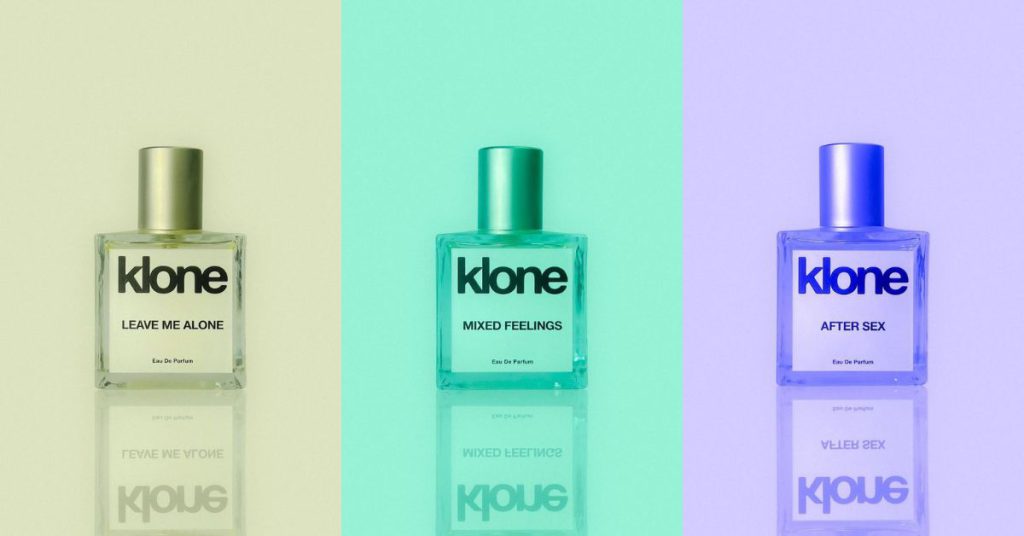
“We prioritise the ‘mood’ first and create a scent that suits the ‘mood’,” Alan said.
This unconventional approach, though met with scepticism by some, underscores Klone’s commitment to forging its own path in the fragrance landscape.
Operating out of their modest studio in PJ, Klone takes a hands-on approach to perfume production, sourcing local alcohol and fragrance oils from international suppliers.
“We blend them by hand with the maceration process before packing them into our own packaging,” Alan shared.
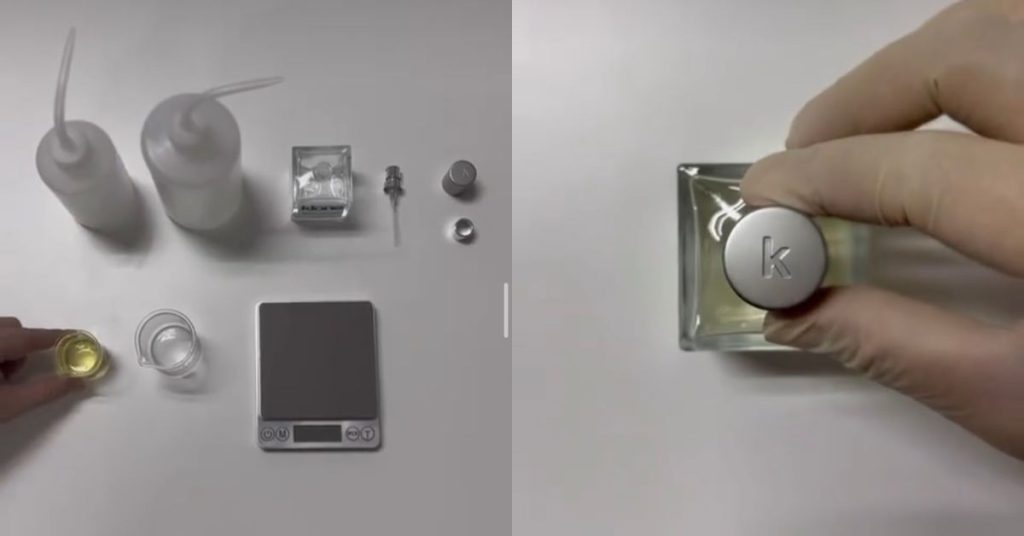
Aspirations for moods
Despite being in business for a mere three weeks, Alan said Klone has already garnered traction, selling over 100 bottles of perfume and accruing a revenue of over RM10K. There’s still a way to go before they break even though, as he shared that their startup capital was more than RM50K.
Looking ahead, Klone harbours aspirations of expansion and growth, with plans to release more moods and solidify its brand concept.
“We are probably looking for consignments in the future,” Alan hinted, alluding to the brand’s potential evolution.
As Klone charts its course in the competitive fragrance market, it’s looking to change the dynamics of people shopping for perfumes.
- You can learn more about the business here.
- Read other article we’ve written about Malaysian startups here.
Also Read: Employees need a Copilot to boost productivity & ease brain drain. This webinar shows how.
Featured Image Credit: Klone
What Malaysia is doing to turn Kuala Lumpur into a top 20 global startup hub by 2030
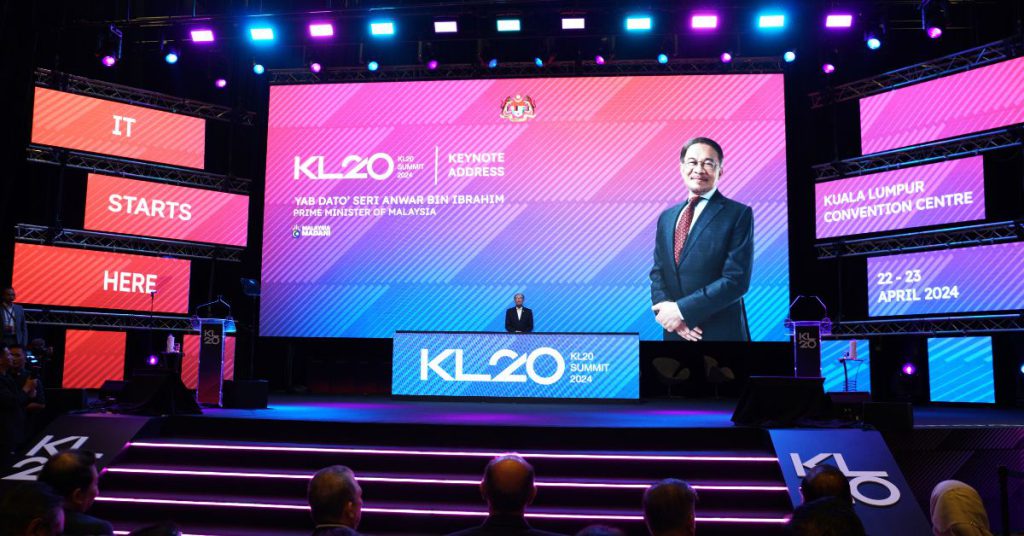
At the much-anticipated KL20 Summit 2024, there was a palpable sense of excitement and hopefulness in the air.
Held in the Kuala Lumpur Convention Centre on April 22 and 23, the event brought in industry leaders from all over the globe, all of them looking towards the same vision—a Kuala Lumpur that ranks as a top 20 global startup hub by 2030.
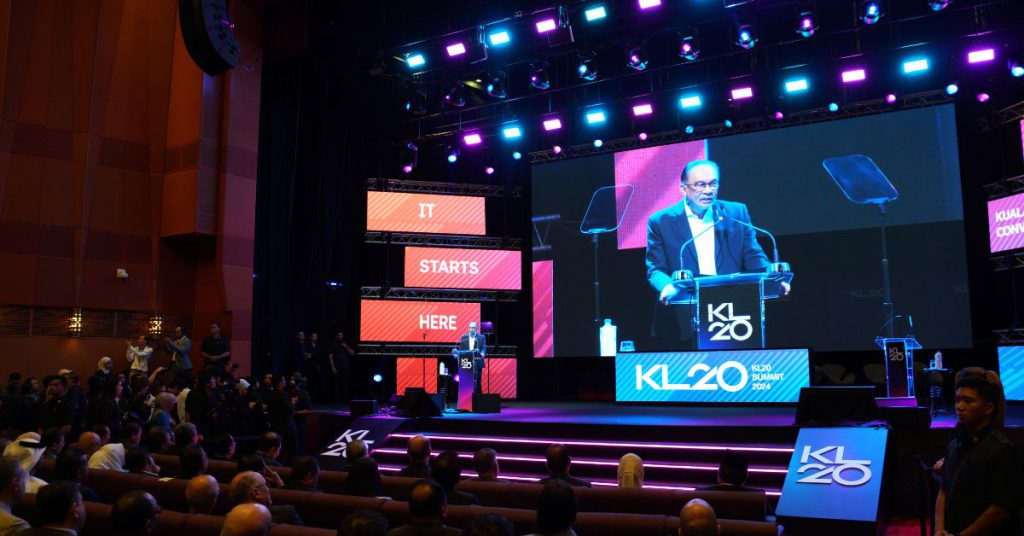
According to Startup Genome’s books, Kuala Lumpur was already considered 20th in the World’s Strong Starters Ranking in 2023. But as of 2022, we hadn’t broken the top 30 yet in terms of the overall ecosystem ranking.
Basically, we’ve got the potential. But there’s a lot of work left to be done.
With that in mind, the KL20 Summit saw the launch of an action paper titled “Unleashing the Full Potential of Malaysia’s Startup Ecosystem”. This paper outlines what the Malaysian government is doing in order to push Kuala Lumpur forward as a startup hub.
Here’s what you need to know.
1. Going all-in on these key sectors
In 2023, Startup Genome had highlighted three “sub-sector strengths” in Malaysia, which were fintech, ecommerce, and healthtech.
But in the Action Paper, the four industries that were specifically highlighted were: energy & green technology, manufacturing and automation, agricultural technology, and Islamic finance.
2. Building a new “belt”
You might’ve heard of the Sun Belt, the Corn Belt, or the Rust Belt. These are popular terms in the United States used to refer to strips of states that share cultural or economical commonalities.
But here’s a new one in Malaysia—the Innovation Belt. Uniting ecosystem players in one area, this seeks to enable collaborations.
Here’s how the envisioned “belt” will look like:
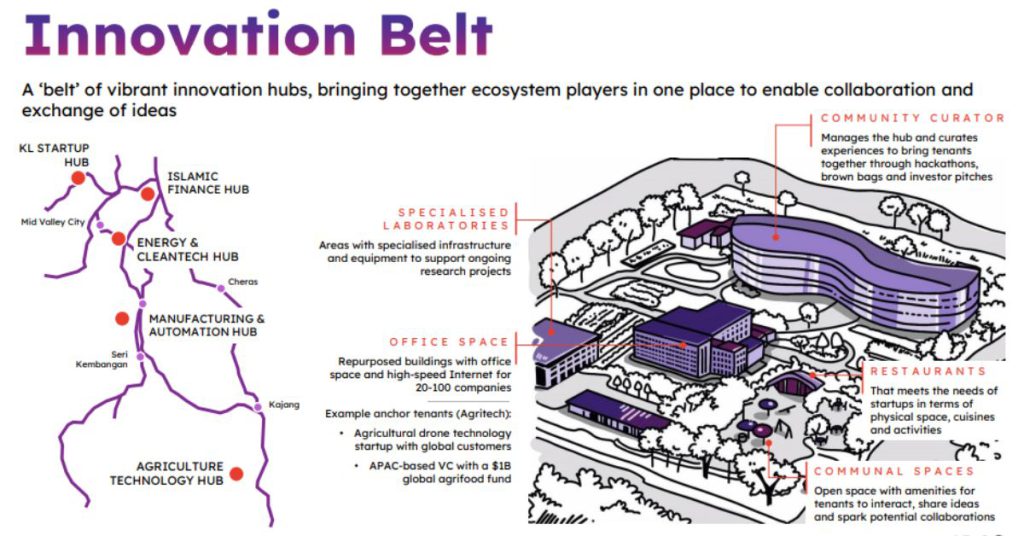
The specific “hubs” that underpin this belt will be the KL Startup Hub, the Islamic Finance Hub, the Energy & Cleantech Hub, and the Agriculture Technology Hub.
3. Incentives for VCs to set up shop in Malaysia
Capital is important, which is why much of KL20 was focused on showcasing Malaysia to potential investors, particular venture capitalists (VCs).
To attract more VCs to branch into Malaysia, the government has created some initiatives.

First, there’s the VC Golden Pass. This targets firms that are a top 100 global or regional VC with AUM (Assets Under Management) of more than US$100 million, and have a strong multi-year track record of investing in and scaling successful tech startups.
The pass offers:
- LP (Limited Partners) funding opportunities from institutional investors
- Secured office space in established startup hubs
- Visa fee exemption for senior leaders
- Networking opportunities with startups, investors, and corporate leaders
- Expedited licence approval for fund setup
In exchange, these VCs must establish a physical office in Malaysia, invest in Malaysian and ASEAN-based startups, and also hire a locally based team to support operations.
There’s also the VC Launch Fund to support the creation of new local VCs to widen funding and investment options for Malaysia’s seed and early-stage startups.
To be eligible, these new funds must be headquartered in Malaysia, focus on seed and pre-seed stage investments, with a target allocation of above 50% being in Malaysia.
Finally, there are plans for a VC Academy to upskill professionals looking to enter the venture capital industry. A four-week course, it is designed for first-time fund managers, new VC analysts, and other young professionals.
The syllabus will cover fundamental skills, knowledge, and an introduction to the local VC landscape,
4. Incentives for startups
In order to attract globally recognised startups to set up a significant presence in Malaysia, the Unicorn Golden Pass was created.
Under this pass, the benefits are:
- Funding opportunities from leading VC investors
- Visas for the team with fee exemptions
- Concessionary tax rate on corporate profits
- Top-tier office space within a startup hub
- Industry-specific benefits tailored to the company
In return, the startup must establish a physical office in Malaysia, build a leadership team here, and also hire a locally based team to support regional operations.
There are other criteria involved, of course. Startups who want to apply for this pass must have a high valuation, be validated by the market, and should also be sustainable long term.
5. Incentives for founders and talents
It’s impossible to carry out all these plans for the ecosystem without the right people. As such, the government also introduced an Innovation Pass.
This is a holistic visa programme that makes it easy for founders and talent to work in Malaysia.
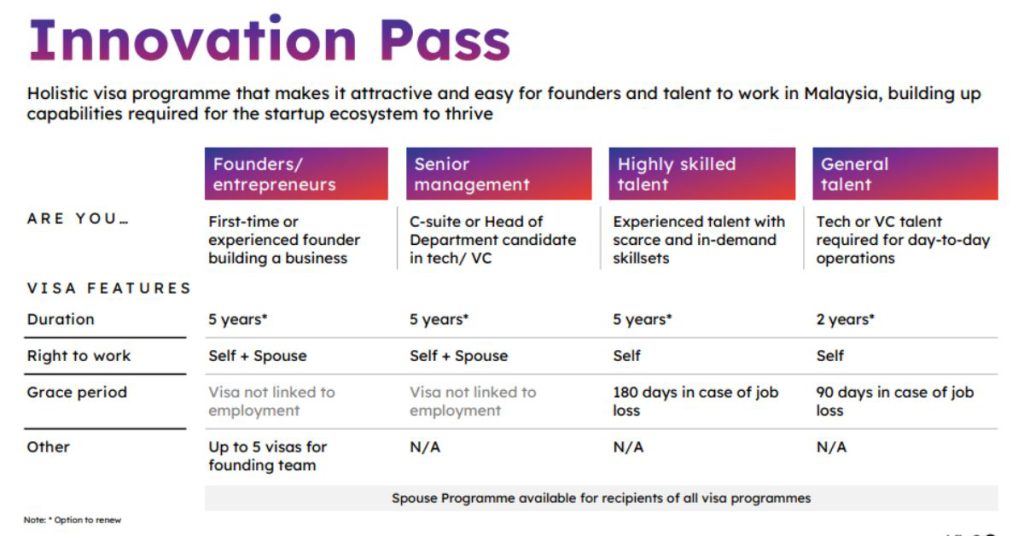
There are specific visa features for founders, senior management, highly skilled talent, as well as general talent. For founders, the pass also grants them up to five visas for the founding team (AKA co-founders).
For founders and senior management, their spouses will have the right to work as well.
They’re also supported by a two-week spouse programme to help them settle in and build a meaningful career in Malaysia.
Ensuring a seamless experience for foreign talents moving to Malaysia, there’s the Founder & Talent Relocation Service that involves consultations, housing assistance, family support, logistics support, admin support, and more.
6. Growing the skills and talents in Malaysia
To cultivate talents, Skills@Scale is a tech skills marketplace to upskill trainees by matching them with experienced trainers from a variety of different backgrounds.
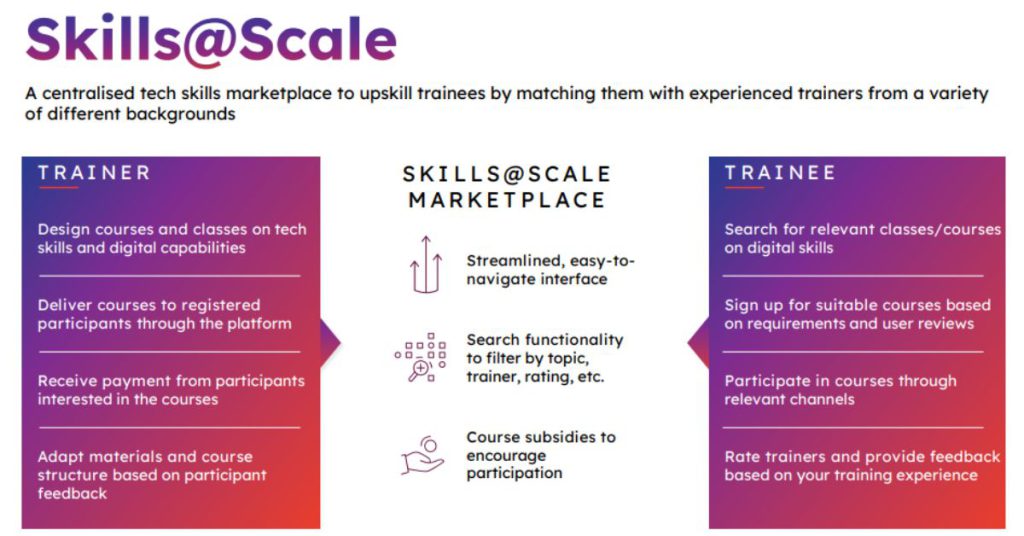
There’s also a three-month programme called Executive Digital Leadership to equip leaders with critical digital capabilities and knowledge to uplift Malaysia’s digital economy.
This programme will be delivered by experts via a blended model that involves in-person and online classes that are curated by MIT.
7. Building a conducive, streamlined ecosystem
The Malaysian startup ecosystem is vast. And with the new programmes, there’s more information than ever to digest for those wanting to break into the scene.
That’s why the Startup Concierge and Single Window are so vital.
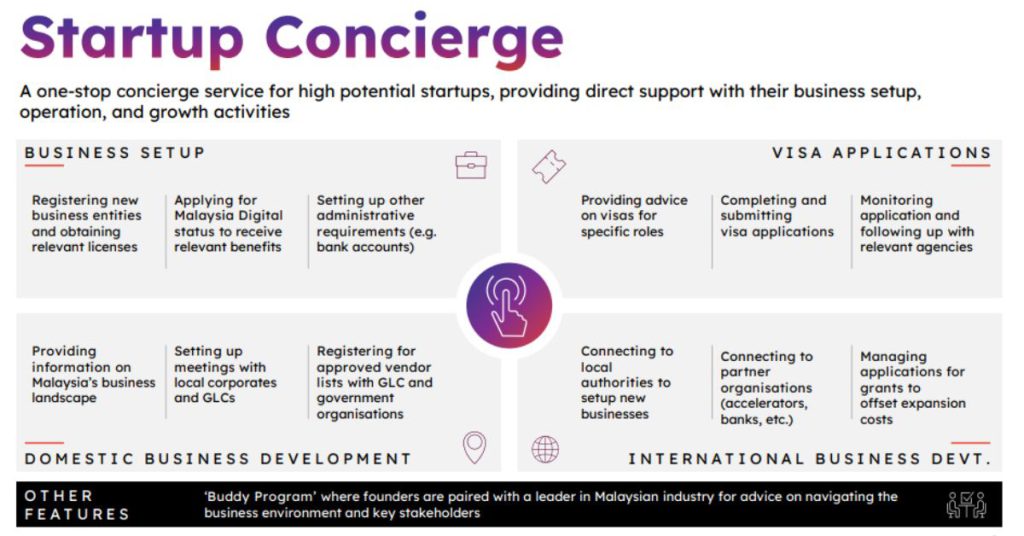
The Startup Concierge is a one-stop concierge service for high-potential startups, providing them direct support with business setup, operation, and growth activities.
Meanwhile, the Single Window is something we’ve been anticipating for a while, since it was even mentioned in the last Budget.
This 8. Looking beyond the country
A crucial component to propel Kuala Lumpur into the top startup hubs in the world is by zooming out. A recurring statement throughout the summit was that Malaysia is “open for business”. That’s why there are so many incentives to bring in foreign talents and funds, while still cultivating our own. And similarly, startups must also look outward and be well-connected with the region and subsequently the globe. As such, Startup City Connect is an effort that aims to foster deep collaboration and integration between Malaysia and other major regions and economies. This will allow startups to operate seamlessly across markets. During the Summit, Intrinsic Innovations, a Canada-based VC firm, showcased its Malaysia-North America Bridge to connect Malaysian entrepreneurs with North America. The summit also saw a Letter of Intent signing between KL and Hangzhou to form a city-to-city connection between the two regions. Overall, through these various programmes and efforts, we’re hopeful and excited to see the Malaysian startup landscape grow and change right before our very eyes. Now, it’s time to make good of the Action Paper as we set sail on the journey to become the top 20 startup hubs in the world.
Also Read: How financial institutions & universities are reshaping their network through AI-native solutions
Featured Image Credit: KL20 Summit 2024
This M’sian startup has a plan to revolutionise our food—with fermented fungus protein
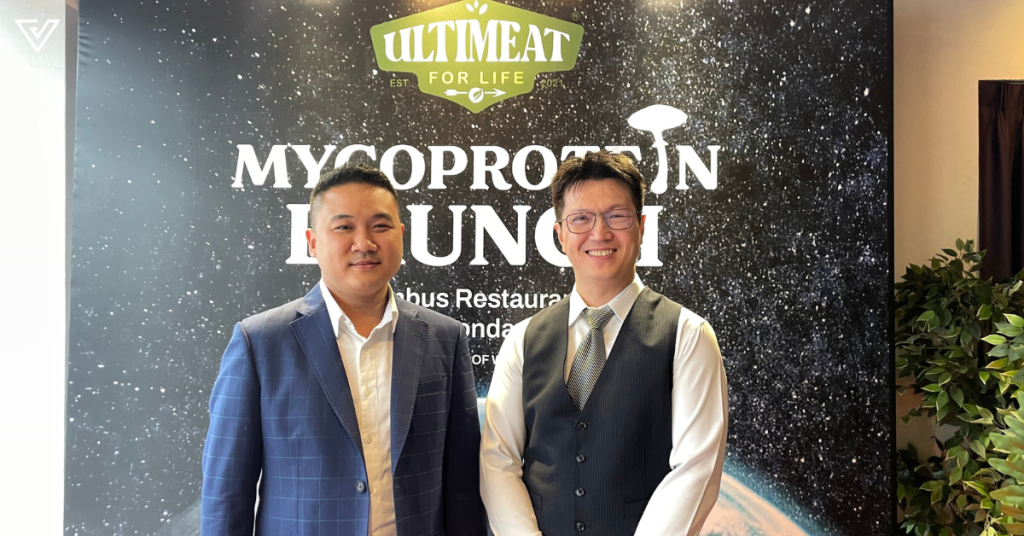
Vegetarian food isn’t exactly uncommon in Malaysia. Sure, it’s not as widespread as it could be, but there are quite a lot of movers and shakers in the scene introducing plant-based options.
In the past year, Vulcan Post has featured relatively young brands like Meamo Foods, Pinxin Vegan Cuisine, In The Pink Co., and VECO Burger, which all address different areas in the vegan F&B landscape.
But one brand that’s been present in the scene for some time now is called VegeWorld, which has been around since 1998.
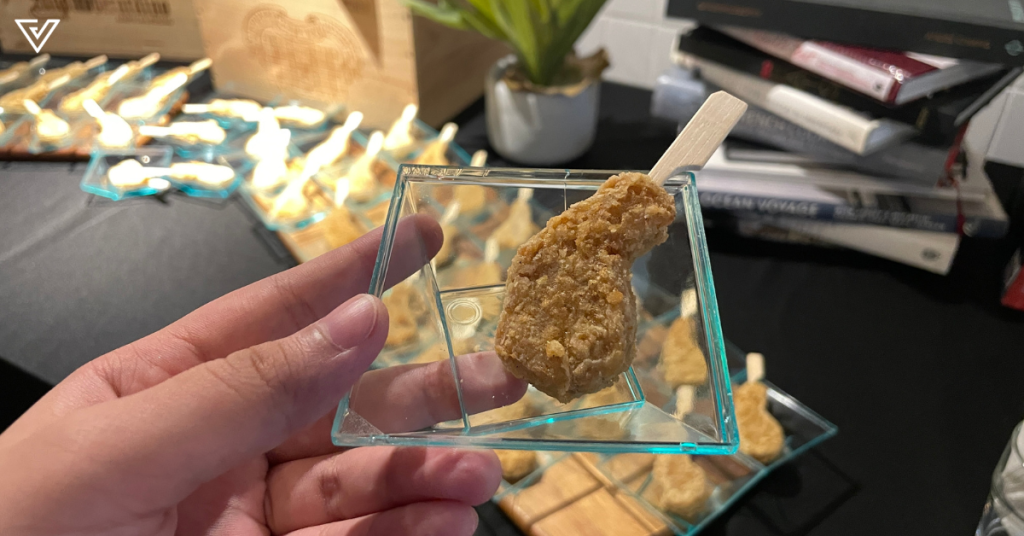
VegeWorld carries products like vegan seafood tofu, vegetarian nuggets, and your usual run-of-the-mill vegan products.
However, in 2021, a new brand would be spawned from this original company. Going by the name of Ultimeat, it aimed to go a step further from what VegeWorld was doing.
Embracing a new age of vegetarian food
A proud third-generation vegetarian, Edwin Lee found fast food options in Malaysia to be incredibly unhealthy. With that, he founded Ultimeat in 2021 to serve that gap with its burger patties and nuggets.
But they aren’t stopping there. Ultimeat isn’t just another plant-based meat alternative in the market. Rather, it’s a biotech startup that’s recently just launched an exciting new product—mycoprotein.
Mycoprotein (mycelium-based protein) is essentially protein derived from fungus. Or to make things even easier, it’s mushroom protein.
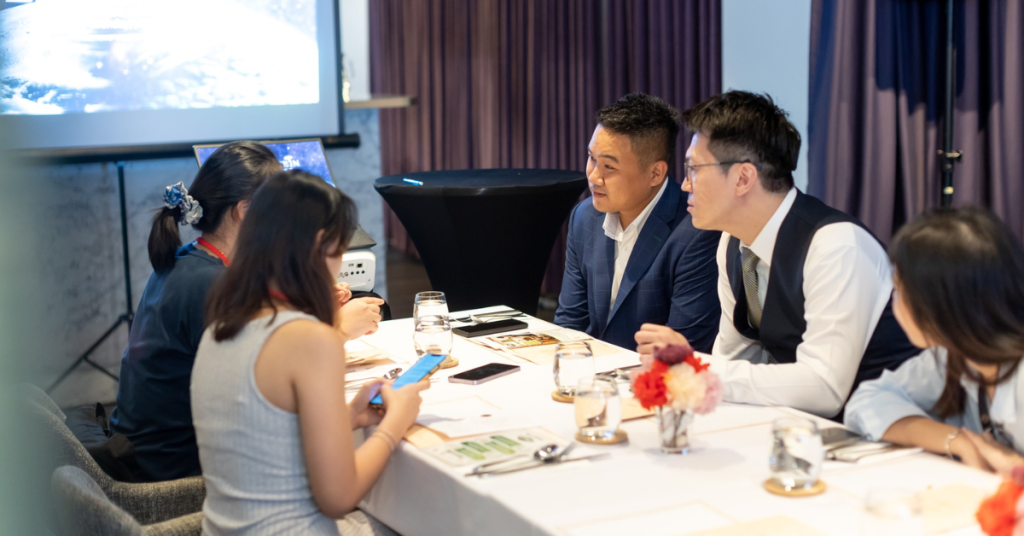
But it’s actually not that simple. Mycoprotein isn’t just mushrooms dressed up to look like real meat. No, it’s actually produced through a process of fermentation, creating what is essentially like animal protein without using any animal cells at all.
Edwin told us that they had restructured the company to go down this route, dubbing it Food 3.0. 2.0, he said, is about plant-based (i.e. soy-based). But, why?
A big motivator for this jump, he said, was economics.
With experience producing soy-based products and other sorts of plant-based meats, Edwin knows firsthand that importing the raw materials is very expensive in Malaysia.
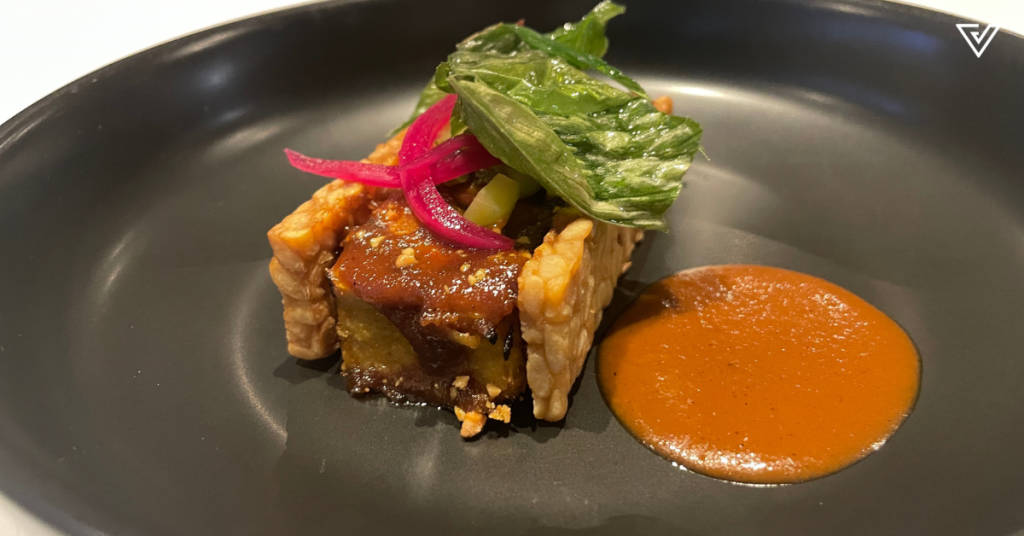
However, with mycoprotein, he said you could just buy the necessary products once, then continue from there.
Dr. Yu-Wei Lin, who is the CTO at Ultimeat, told Vulcan Post that fermentation technology is highly sustainable as there is no need for a farm, just a tank. The equipment used by the startup is being designed internally, too.
With these developments, Ultimeat is now regarded as the first innovative precision biotech fermentation Malaysian company that produces meat replacement products.
All products are made in their Klang factory, though their lab is in located in a MRANTI facility.
The better choice?
When asked about how mycoprotein stands out when compared to all the other meat alternatives (such as jackfruit-based meat to lab-grown meat), Edwin simply said, “This is a different space.”
Plant-based and fruit-based meats belong in Food 2.0, while cultivated meats still have a long way to do in order to be scalable.
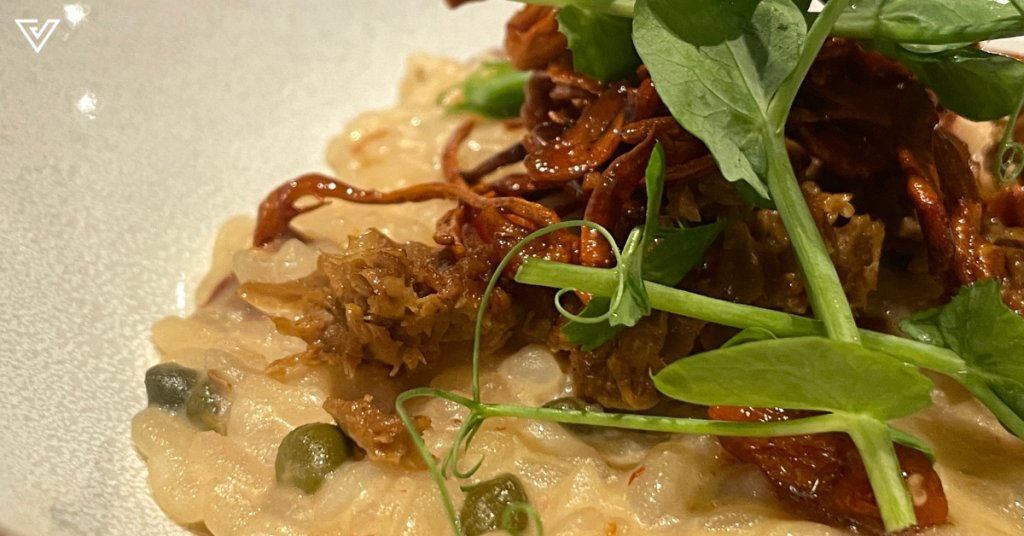
Indeed, financial and environmental sustainability aside, another great thing about mycoprotein is that it’s scalable. This scalability allows it to address concerns of food security as well.
“We don’t need any more plantations,” he said. “We can duplicate this technology in any country.”
In fact, Edwin said Ultimeat is already collaborating with businesses in various companies in the APAC region, sharing their fermentation technology with people who can use them.
The future of protein, the protein of the future
At the end of the day, it all comes down to acceptance. Can Malaysians (and those beyond) really accept this “meat”?
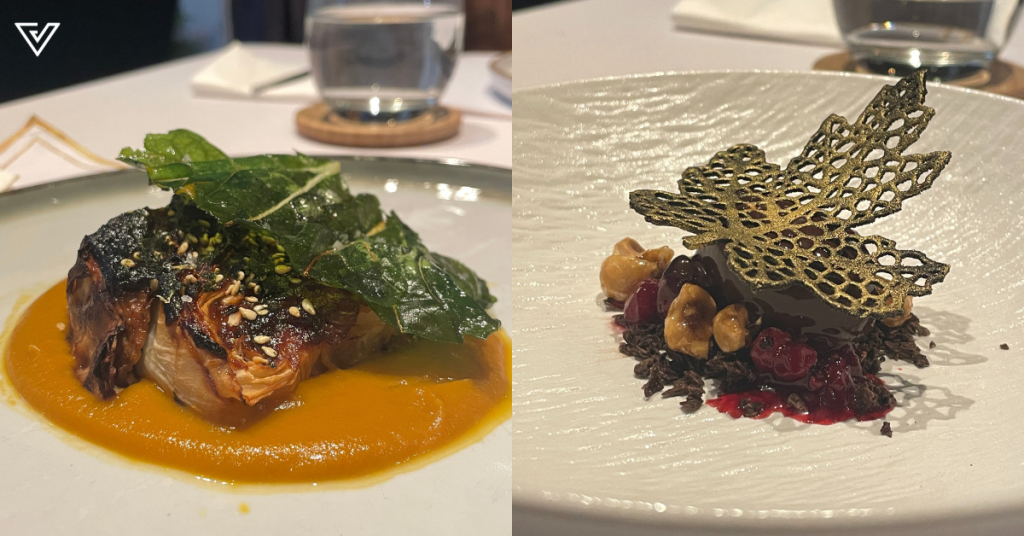
Taste would play a big role in answering that. Recently, we were invited to Nimbus Restaurant in Damansara Utama to enjoy a six-course tasting menu that incorporates Ultimeat’s mycoprotein. And yes, every single dish used the product—even the dessert.
Compared to other vegan proteins we’ve tried, it’s a much more neutral-tasting product. You can read further about our experience here.
Before acceptance, though, awareness and education must also take place. The strategy for Ultimeat is to make the information digestible.
Aside from end consumers like myself, though, Ultimeat will also be targeting other businesses such as restaurants, especially those who are cognisant of their carbon footprint.
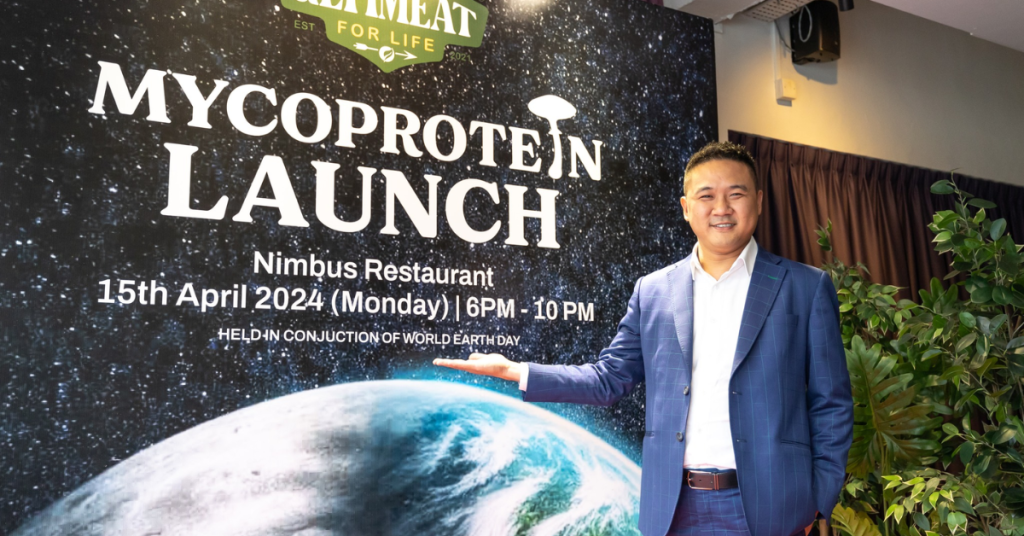
This means explaining mycoprotein in simple terms (i.e. mushroom protein, rather than fermented protein), and pointing out the nutritional benefits of using mushroom instead of, say, soy (it has higher dietary fibre).
Edwin revealed that Ultimeat will be rolling out its mycoprotein products in the next quarter, starting from ecommerce avenues. The range will include not just various ready-to-eat items, but even a protein drink.
From there, the big-picture vision would be making this mycoprotein-based meat the ultimate meat substitute of the future.
Also Read: Here’s how OCBC Business is making it easy for M’sian SMEs to offer cross-border QR payments